State Report Card
Higher Education Act (HEA) Title II Report Cards on State Teacher Credentialing and Preparation
WMarMANUAL_draft_final
State Report Card
OMB: 1840-0744
DRAFT March 2009
Preliminary Draft – March 2009
Higher Education Act of 1965, as amended in 2008 by the Higher Education Opportunity Act
HEA
Title II
![]()
Reporting Reference and User Manual
U.S. Department of Education
Office of Postsecondary Education

OMB Control No. 1840-0744 (expiration date: XX/XX/20XX)
Paperwork Burden Statement
This is a required data collection. Response is not voluntary. According to the Paperwork Reduction Act of 1995, no persons are required to respond to a collection of information unless such collection displays a valid OMB control number. The valid OMB control number for this information collection is 1840-0744 (expiration date XX/XX/20XX). The time required for institutions to complete this information collection is estimated to average 96 hours per response, including the time to review instructions, search existing data resources, gather the data needed, and complete and review the information collection. The time required for states to complete this information collection is estimated to average 10,930 hours per response, including the time to review instructions, search existing data resources, gather the data needed, and complete and review the information collection. If you have any comments concerning the accuracy of the time estimate(s) or suggestions for improving this form, please write to: U.S. Department of Education, Washington, DC 20202-4651. If you have comments or concerns regarding the status of your individual submission of this form, write directly to: Assistant Secretary, Office of Postsecondary Education, U.S. Department of Education, 1990 K Street, NW, Room 7115, Washington, DC 20006.
Contents
Part I. Overview of HEA Title II Reporting Requirements
A. Introduction 1
B. Reporting Requirements—Institutions 2
C. Reporting Requirements—States 3
D. Reporting Cycles 4
E. Key Definitions 7
F. Pass Rates 8
Part II. Institutional Reporting Requirements
A. Required Reporting for Institutions of Higher Education 14
B. Information for Institutions Reporting for the First Time 15
Part III. Using the SRS for State Reporting
A. Introduction 18
B. Procedures for States Reporting for the First Time 19
C. System Security 19
D. Logging In and Logging Out 20
E. System Features 23
F. Report Navigation 28
Contact Information 30
Section
I: Description of State Teacher Certification or
Licensure
Assessments and Other Requirements 31
Sections
I.a., b., & d.: Requirements to Obtain Level I, II and III
Certificates 31
Section
I.e.: Specific Assessment Requirements and Cut Score
Table 33
Section
I.f.: Provisions for Persons Teaching Without Full
Certification
or Licensure 35
Section
II: Description of State Teacher Standards and the Alignment
Between
State Teacher Certification or Licensure Requirements and
Assessments
and State Student Standards and Assessments 37
Section III: Statewide and Institutional Pass Rates 38
Section
IV: Description of Criteria for Assessing the Performance of
Teacher
Preparation Programs within Institutions in the State 43
Section V: List of Low-Performing State Teacher Preparation Programs 44
Section
VII: Alternative Routes to Teacher Certification or Licensure,
and
Pass Rates for Program Completers of Alternative Routes 46
Section VIII: State Efforts To Improve Teacher Quality 49
Section IX: Certification 50
Printing Your State Report 52
Uploads and Templates 53
Pass Rate Tips 55
Instructions 60
Appendices
Appendix A Statutory Provisions A-1
Appendix B Glossary B-1
Appendix C Institutional Survey C-1
Appendix D State Survey D-1
Tables
I.D.1. Reporting
deadlines for the institutional, state and Secretary’s
reports:
2006-07 through 2008-09 4
I.D.2. Data collection year/cycle 5
I.D.3 Sequence of pass rate reporting 8
I.D.4 Calculating aggregate and summary pass rates 11
Figures
III.C.1. Time-out warning 20
III.D.1. Login screen 21
III.D.2. Initial password change 22
III.D.3. Log out 23
III.E.1. Radio buttons and text boxes 24
III.E.2. Check boxes 25
III.E.3. Add/Edit/Delete 26
III.E.4. Reference and Web Address 27
III.F.1. Main menu 29
III.F.2 Contact information 30
III.F.3. Section I 31
III.F.4. Sections I.a, b, and d. 32
III.F.5. Section I.e. 33
III.F.6. Section I.e Requirements 34
III.F.7. Section I.e Cut Score Table 35
III.F.8 Section I.f. 36
III.F.9 Section II 37
III.F.10. Section III 39
III.F.11. Tables D1-D2 and Tables D1a-D2a 40
III.F.12. Entering or editing a table 41
III.F.13. Adding a table item 42
III.F.14. Section IV 43
III.F.15. Section V 44
III.F.17. Section VII 46
III.F.18. Table D5 48
III.F.19. Section VIII 49
III.F.20. Certification verification 50
III.F.21. Certification 51
III.F.22. Print menu 52
III.F.23. Uploads 54
III.F.24. Templates 57
III.F.25. File download 58
III.F.26. Template for Table D1. 59
III.F.27. Instructions 60
Part I: Overview of HEA Title II Reporting Requirements
Introduction
In October 1998, Congress voiced its concern for the quality of teacher preparation by enacting Title II of the Higher Education Act (HEA). In August 2008, Congress demonstrated its continuing interest through the passage of the Higher Education Opportunity Act (HEA), which amends the HEA in a number of ways. Title II authorizes federal grant programs that support the efforts of states, institutions of higher education and their school district partners to improve the recruitment, preparation and support of new teachers. Title II also includes accountability measures in the form of reporting requirements for institutions and states on teacher preparation and licensing. Sections 205 through 208 of the statute are provided in Appendix A.
Section 205 of HEA Title II requires reports from two groups:
Institutions of higher education (IHE) that conduct traditional teacher preparation programs or alternative routes to state certification or licensure programs, enrolling students who receive federal assistance under Title IV of the HEA. A teacher preparation program is a state-approved course of study, the completion of which signifies that an enrollee has met all the state’s educational and/or training requirements for initial certification or licensure to teach in the state’s elementary, middle or secondary schools. A teacher preparation program may be either a traditional program or an alternative route to certification, as defined by the state. Also, it may be within or outside an institution of higher education. A traditional teacher preparation program primarily serves undergraduate students without prior teaching or work experience and leads at least to a bachelor’s degree1; an alternative route to state certification or licensure, although primarily serving candidates that are the teacher of record in a classroom while participating in the route, is defined by each state. (See Appendix B, Glossary.) Section 205 (a)(3) requires institutions to submit timely and accurate reports or incur a fine of up to $27,500.
States that receive HEA funds. The term “state” includes the 50 states, the District of Columbia, Puerto Rico and the outlying areas. (See Appendix B, Glossary.) States must submit the reports as a condition of receiving HEA funding. NOTE: The manual uses the terms “state” and “state agency” interchangeably to refer to the part of the state government that has responsibility for establishing procedures to implement the Title II HEA reporting requirements.
States and institutions must report on all of the items on the questionnaires, using the definitions and methods for calculating pass rates and other statistics developed by the U.S. Department of Education (ED). States may choose to collect information from institutions using either the standard questionnaire or another reporting format—as long as the institutions and states include, at a minimum, the information requested on the standard questionnaire. If states choose to design their own reporting formats, they are encouraged to do so through collaboration with their institutions and through the use of standardized spreadsheets or reports that minimize the burden on institutions.
States have the central coordinating role in the Title II system of institutional and state reporting, so they must be responsible for promoting public confidence in the information that institutions and they report. Thus to the extent possible, states and institutions must ensure that the data provided in their reports are complete and accurate and conform to the definitions in the manual.
This section provides a general overview of HEA Title II reporting for institutions and states, including reporting requirements and cycles, key definitions and guidance on how pass rates should be generated.
B. Reporting Requirements—Institutions
Section 205(a)(1) requires each institution to establish, and report annually on:
Annual quantifiable goals for increasing the number of prospective teachers trained in teacher shortage areas (see Section 206(a) and Appendix B, Glossary for the definition of teacher shortage areas);
Assurances that training provided to prospective teachers responds to local or state needs and is closely linked to school needs and the needs of new teachers; that prospective special education teachers receive coursework in core academic subjects and instruction in teaching them; that general education teachers receive training in providing instruction to diverse populations; and that prospective teachers receive training in how to be effective in rural and urban schools, as applicable (see Section 206(b));
How well individuals who enroll in and complete its teacher preparation program perform on initial state licensing and certification assessments;
Basic aspects of its program, such as: criteria for admission into the program; number of students, disaggregated by race, ethnicity and gender; amount of required supervised clinical experience; the number of students and full-time equivalent faculty in the supervised clinical experience; and the total number of students certified or licensed as teachers, disaggregated by subject and area of certification or licensure;
Descriptions of the activities undertaken in the program to prepare teachers to integrate and use technology in instruction, and to teach students with disabilities and limited-English-proficient students effectively; and
Whether the program is accredited, and if it is classified by the state as “low-performing.”
A copy of the Institutional Survey is provided in Appendix C.
C. Reporting Requirements—States
Section 205 (b) requires each state to report annually on:
The reliability and validity of teacher certification or licensure assessments and any other certification or licensure requirements;
The standards and criteria for initial teacher certification and licensure for particular academic subjects, areas, or grades;
The alignment between teacher certification or licensure assessments (and other requirements) and the state’s academic content standards or early learning standards for early childhood education;
Pass rates and average scaled scores for each assessment, by the same subgroups reported for each IHE, for both traditional and alternative route programs in the state;
Descriptions of alternative routes to teacher certification or licensure in the state;
Description of the state’s criteria for assessing the performance of teacher preparation programs, including indicators of academic content knowledge and teaching skills of enrollees in the programs;
For each teacher preparation program in the state, basic aspects of its program, such as: criteria for admission into the program; number of students, disaggregated by race, ethnicity and gender; amount of required supervised clinical experience; the number of full-time equivalent faculty, adjunct faculty, and students in the supervised clinical experience; and the total number of students certified or licensed as teachers, disaggregated by subject and area of certification or licensure;
For each teacher preparation program and the state as a whole, the number of teachers certified or licensed, by area of certification or licensure, academic major, and subject area for which the teacher has been prepared to teach; and
Description of the extent to which teacher preparation programs in the state are addressing shortages of highly qualified teachers, are preparing teachers to effectively teach students with disabilities, preparing teachers to integrate and use technology in instruction, and are preparing teachers to effectively teach students who have limited English proficiency.
Appendix D contains the State Survey.
The data that states and institutions will provide annually represent one way we measure the success of teacher education programs and state efforts to improve teacher quality. It is ED’s hope, and the desire of Congress, that institutions and states use the reports in meaningful ways to improve teacher education in America.
D. Reporting Cycles
Section 205 of Title II requires the annual preparation and submission of three sets of reports on teacher preparation and licensing: one from institutions to states, a second from states to the U.S. Secretary of Education and a third from the Secretary to Congress and the public. Table I.D.1 shows the due dates for each of the three reports by reporting year, assuming that data collection instruments and procedures are approved by 9/30/2009.
Table I.D.1. Reporting deadlines for the institutional, state and Secretary’s reports: 2009-10 through 2011-12 |
|||
|
|
|
|
Reporting year2 |
Institutional report |
State report |
Secretary’s report |
2009-10 |
April 1, 2011 |
October 31, 2011 |
April 1, 2012 |
2010-11 |
April 1, 2012 |
October 31, 2012 |
April 1, 2013 |
2011-12 |
April 1, 2013 |
October 31, 2013 |
April 1, 2014 |
The surveys use elements from different points in time. For example, certification requirements are based on the most current information available, while the pass rates are based on an academic year. We have included a reference table (see Table I.D.2) that shows each survey section and the corresponding data collection year/cycle.
Table I.D.2. Data collection year/cycle |
|
|
|||||
|
|
|
Reporting year |
||||
Section |
Page(s) |
Item |
2011-123 |
2012-13 |
2013-14 |
||
I |
|
Program information (admissions, demographics, supervised clinical experience, number prepared) |
Academic year 2009-10 |
Academic year 2010-11 |
Academic year 2011-12 |
||
II |
|
Reliability and validity |
Most recent information |
Most recent information |
Most recent information |
||
III |
48-53 |
Description of certification/licenses |
Most current state regulations |
Most current state regulations |
Most current state regulations |
||
IV |
55-58 |
State standards |
Most current state regulations/policies |
Most current state regulations/policies |
Most current state regulations/policies |
||
V |
58-64 |
Institutional, alternative route and state pass rates |
Academic year 2009-10 Academic year 2008-09 Academic year 2007-08 |
Academic year 2010-11 Academic year 2009-10 Academic year 2008-09 |
Academic year 2011-12 Academic year 2010-11 Academic year 2009-10 |
||
VI |
|
Alternative route programs |
Most current state regulations/policies |
Most current state regulations/policies |
Most current state regulations/policies |
||
VII |
65 |
Description for assessing performance of teacher preparation programs |
Most current state regulations/policies |
Most current state regulations/policies |
Most current state regulations/policies |
||
VIII |
65 |
Low performing |
Most current review cycle |
Most current review cycle |
Most current review cycle |
||
IX |
|
Shortages of highly qualified teachers |
Most recent information |
Most recent information |
Most recent information |
||
X |
|
Teacher training |
Most recent information |
Most recent information |
Most recent information |
||
XI |
|
Use of technology |
Most recent information |
Most recent information |
Most recent information |
||
XII |
|
Efforts to improve teacher quality |
Most recent information |
Most recent information |
Most recent information |
||
Key Definitions
States and institutions need to understand several key definitions in order to complete their annual reports accurately.
Teacher Preparation Program: A state-approved course of study, the completion of which signifies that an enrollee has met all the state’s educational and/or training requirements for initial certification or licensure to teach in the state’s elementary, middle or secondary schools. A teacher preparation program may be either a traditional program or an alternative route to certification, as defined by the state. Also, it may be within or outside an IHE.
A traditional teacher preparation program primarily serves undergraduate students without prior teaching or work experience and leads at least to a bachelor’s degree4; an alternative route to state certification or licensure, although primarily serving candidates that are the teacher of record in a classroom while participating in the route, is defined as such by each state.
For purposes of reporting under the Act, if an institution operates more than one state-defined traditional teacher preparation program, the institution’s multiple programs must be regarded as a single program.
Program Completer: A person who has met all the requirements of a state-approved teacher preparation program. Program completers include all those who are documented as having met such requirements. Documentation may take the form of a degree, institutional certificate, program credential, transcript or other written proof of having met the program’s requirements. In applying this definition, the fact that an individual has or has not been recommended to the state for initial certification or licensure may not be used as a criterion for determining who is a program completer.
Alternative Route to Certification or Licensure: A teacher preparation program that primarily serves candidates that are the teacher of record in a classroom while participating in the route. Alternative route teacher preparation programs are defined as such by the state.
Traditional Teacher Preparation Program: A teacher preparation program that primarily serves undergraduate students without prior teaching or work experience and leads at least to a bachelor’s degree.5 Any teacher preparation program that is not an alternative route to initial certification or licensure.
Nonclinical coursework: Any course in the teacher preparation program curriculum that focuses on content, such as academic subject matter, and does not require students to participate in the activities of supervised clinical experience as described in the glossary definition may be counted as nonclinical coursework. The curriculum policies of each state and its institutions will identify coursework that is nonclinical or clinical. See Supervised clinical experience.
Pass Rates
States and institutions must collect and report pass rate data in a uniform manner. Such data are to be calculated using the following procedures.
Report pass rates annually. Institutions report pass rate data to states in April of each year. States, in turn, report the institutional and state pass rates to ED annually in October. See Table I.D.1 for a summary of reporting deadlines.
Set the academic year and test closure date for each cohort of program completers. Working in collaboration, states and institutions need to set a test closure date for each cohort of program completers. The date should be the same for all institutions within a state. The academic year will be defined as starting September 1 and ending August 31.
Institutions and states report annually on five groups. Every institutional report (and the portion of every state report containing institutional pass rates and scaled scores) will include pass rates and scaled scores on the most recent cohort of completers, pass rates and scaled scores for completers in each of the two previous years, pass rates and scaled scores for all students who have completed all nonclinical coursework, pass rates and scaled scores for all other enrolled students, as well as updated pass rates and scaled scores on the cohort that finished the program 3 years earlier. This same sequence applies to the state’s reporting of pass rates and scaled scores of cohorts that complete alternative routes to certification and licensure and traditional programs outside of IHEs. Table I.D.3 illustrates this pattern:
Table I.D.3: Sequence of pass rate and scaled score reporting
Cohort year |
Report year 2010-11 |
Report year 2011-12 |
Report year 2012-13 |
2007-08 |
Pass rates/scaled scores |
|
|
2008-09 |
Pass rates/scaled scores |
Pass rates/scaled scores |
|
2009-10 |
Pass rates/scaled scores |
Pass rates/scaled scores |
Pass rates/scaled scores |
2010-11 |
|
Pass rates/scaled scores |
Pass rates/scaled scores |
2011-12 |
|
|
Pass rates/scaled scores |
This form of updating pass rate and scaled score data conforms to requirements of section 205 of Title II. It is needed so that the pass rates and scaled scores on certification or licensure examinations reflect the scores of all enrolled students and program completers who took the examination during or immediately after finishing a teacher preparation program or within each of the two years thereafter. When reporting pass rates and scaled scores for program completers in each of the two years after program completion, the pass rates and scaled scores must contain the most recent data and not be a reiteration of the data reported the year before. Thus, states will be reporting an update on the pass rates and scaled scores of each cohort of program completers for each of the two years following program completion.
Pass rates and average scaled scores must be calculated for all tests that are used by the state for initial teacher certification or licensure. Testing companies or states will need to collect a comprehensive list of all certificates or licenses (for areas of specialization approved by the state) for the academic year, the requirements and cut scores for certificates or licenses and the teacher preparation programs and the certificates or licenses for which they are approved, to be able to calculate and report pass rates and average scaled scores for the groups of traditional and alternative route program test takers.
The tests and cut scores used to determine pass rates must be valid for the initial certification of each individual test taker as of the test closure date. States change their test requirements from time to time, and individuals within a particular completer cohort may have taken the same tests under different cut-score requirements. Some states “grandfather in” (and so count as a “pass” when they calculate the cohort pass rate) completers who previously passed a test with a score below the current cut score or who passed a different test. Other states do not. It is up to the state to determine the tests and cut scores that it considers valid for an individual at the time of the test closure date for his or her cohort. Pass rates must be based on these valid tests and cut scores.
Pass rates will likely be calculated either by testing companies or by states that have test files. The rates will be reported for each academic year’s groups of test takers for tests related to the test taker’s area of specialization. These tests must be valid for the individual test taker as of the test closure date. In cases where a test taker has taken the same test more than once, the result of the test on which the test taker attained the highest score is to be used.
Pass rates will be computed using the “rule of 10.” In order for data on an assessment to be reported, at least 10 students had to have taken the assessment in an academic year. Summary data also require at least 10 test takers (though not necessarily taking the same assessment) for the data to be reported.
Institutions and states will report two kinds of pass rates.
A single assessment pass rate is defined as the proportion of test takers who passed the assessment among all who took the assessment.
2. Summary pass rates are defined as the proportion of test takers who passed all tests they took for their areas of specialization among those who took one or more tests in their specialization areas. Summary pass rates are based on all assessments that an individual needs to pass to become initially certified or licensed as a teacher in a given area of specialization in a state.
If a state requires portfolios or other performance assessments on which candidates receive a pass-fail designation, pass rates must be reported in the “Performance Assessments” category of the report. In addition, in some states, a single score is given across two or more tests. In those instances, the single score for the set of multiple tests should be used in calculating a pass rate for that set.
If a state does not require any tests for initial certification, they are still required, to the extent practicable, to collect comparable pass rate and scaled score data and report it (cf. Section 208 (b)).
The sample table below illustrates summary pass rates. If a candidate begins the series of assessments required and passes all the assessments taken, he or she is counted for purposes of institutional pass rates as a pass. If a candidate begins a series of assessments and fails one or more before the test closure date, he or she is counted as a fail for purposes of institutional pass rates.
Information States Must Report Regarding Individuals Who Completed Teacher Preparation Programs in Another State
States are not required to report the pass rates of individuals who completed teacher preparation programs in another state. States do need to report, however, the total number of individuals for each reporting period who receive their initial teaching certification or licensure and the number of these individuals who completed teacher preparation programs in another state.
Processes Used by Institutions, State, and Testing Companies To Calculate Pass Rates
Following the procedures established in each state, each institution will identify its traditional and alternative route test takers by Social Security number or other identifying information, together with their areas of specialization and academic major, and provide this information to the testing companies or state. The testing companies or state will then compute the pass rates (on assessments in the certification and licensure areas that correspond to these areas of specialization) of the institution’s test takers and return the pass rates to the institution. The testing companies or state also will provide the institution other information that it can use to verify the pass rates.
For states and institutions using tests from more than one testing company, the single pass/fail ratings for each test will be combined into a summary pass/fail rating for each individual across all tests the individual is required by the state to take for licensure or certification, regardless of testing company. Reports will continue to show the number of individuals taking each test (noting from which testing company each test is obtained), the passing score and pass rate for each test, and the summary pass rate for all individuals taking all tests needed for certification or licensure; they will also provide the average scaled score for each test. States will develop a similar procedure to obtain single-test and summary pass rates from participants and completers of non-IHE alternative route programs.
Table I.D.4 Calculating summary pass rates
Program completer |
Test 1 |
Test 2 |
Test 3 |
Test 4 |
Test 5 |
Test 6 |
Summary pass status |
1 |
P |
P |
P |
F |
--- |
--- |
F |
2 |
P |
P |
--- |
--- |
--- |
--- |
P |
3 |
P |
P |
F |
--- |
--- |
--- |
F |
4 |
F |
--- |
--- |
--- |
--- |
--- |
F |
5 |
P |
--- |
--- |
--- |
--- |
P |
P |
6 |
P |
F |
P |
--- |
--- |
--- |
F |
7 |
P |
F |
P |
--- |
--- |
--- |
F |
8 |
P |
P |
P |
P |
F |
|
F |
Pass rate = % passing |
88% |
67% |
80% |
50% |
0% |
100% |
Summary pass rate = 25% |
Institutional Verification of Pass Rates
Because institutions will be held accountable for the pass rates of their test takers, they need to have confidence in the pass rates that they report. Thus, institutions must be able to receive timely data from testing companies or state agencies to verify the accuracy of pass-rate calculations and, if necessary, resolve any disagreements about what these pass rates should be. The test companies or state will also provide the institution other information that it can use to verify the pass rates, such as linked data that identifies test takers and shows their individual scores. States and institutions using tests from more than one test company may verify their combined pass rate reports using linked data, when authorized. State agencies will need to collaborate with public and private institutions and testing companies to ensure that their procedures for implementing the section 205 reporting requirements let institutions do this.
Data Institutions Will Receive
At a minimum, verification procedures must let each institution receive all of the examination scores that the testing companies or state agency used to compute its pass rates, together with information that identifies all test takers who took each examination. Moreover, each institution must receive this information in sufficient time to enable it to verify the calculated pass rates, resolve any discrepancies and submit the required institutional report by the due date.
In some states, state laws and procedures will permit institutions to receive information (e.g., Social Security numbers) that links the test scores to each individual test taker. Although using these “linked data” is not required, ED recognizes that they are the best and most desirable information available. In this regard, the procedures discussed in this manual for providing institutions with these linked test-score data are consistent with federal law, including the Family Educational Rights and Privacy Act (FERPA).
ED also recognizes, however, that in some states, state law or compelling state policy prohibits the linking of test scores and test taker names. For example, state law may preclude institutions from securing the test scores of individual test takers without their consent or disallow state agencies from being the conduit through which testing companies can provide individual test scores to the respective institutions, out of fear that test scores maintained by the state agency would become records that are publicly available without consent. (Under FERPA, however, test scores linked to the names of test takers are not publicly available so long as the state agency and institutions in the state agree that, in maintaining these records, the state agency is acting on behalf of the institutions so that they can verify their pass rates.) ED believes that it is vital for states to overcome these kinds of problems so that institutions can verify pass-rate calculations using linked test-score data. To this end, the Department is prepared to work with states and others to help them find ways to achieve this objective.
Unless teaching candidates have agreed to release their test scores to an institution, the institution has no legitimate interest in retaining a particular candidate’s scores once it has verified the testing companies’ pass-rate calculations. The Department urges states and institutions to agree to procedures under which the institutions will destroy these linked scores once they are no longer needed for institutional reports.
Dispute Resolution Procedures
In most cases, an institution should be able to receive from the testing companies or state the test-score and test-taker data that state procedures permit and to confirm the accuracy of pass-rate calculations. However, it is possible that in a small number of cases an institution either will not receive these data or will not be able to resolve disagreements about how the pass rates should be calculated. To accommodate these situations, the state’s implementing procedures must contain the following elements.
If an institution cannot secure data in a timely manner, the institution must promptly inform the state and ED, in writing, of the problem. The institution also must propose a schedule for reporting to the state the required pass rates, based on the testing companies’ (or state’s) estimate of when the institution will receive the data it needs to report. The state either will accept the schedule or will work to resolve the problem.
If an institution cannot resolve a disagreement with the testing companies or state about how to calculate its pass rate(s), the state will use an impartial process for receipt and resolution of disputes in time to permit the institution to prepare its report. This process must include procedures for the institution to send a written explanation of the dispute to the state within 10 days of reaching an impasse with the testing companies. In the event the institution reaches an impasse with the state, the process also must include procedures for the state and institution to send written explanations of the dispute to the Department within 10 days. (The Department will provide its resolution of the dispute as quickly as possible on the basis of these written explanations so that the institution can report on schedule.)
Part II: Institutional Reporting Requirements
IHEs are required to submit their HEA, Title II surveys to the state in April of each year. See Part 1, including Tables I.D.1 and I.D.2, for an overview of the Title II reporting schedule.
States are responsible for developing and implementing the collection of IHE data and have developed forms or on-line systems for IHE use. A list of state Title II coordinators can be found at https://title2.ed.gov/contactsState.asp. A sample data collection instrument is provided in Appendix C.
In addition to completing the Institutional Survey, IHEs are required to report the mandated elements of the Institutional Survey and assessment pass rates and scaled scores to the general public (see Section 205(a)(1)).
A. Required Reporting for Institutions of Higher Education
Pass rates and scaled scores on teacher assessments for all students enrolled in and program completers of traditional and alternative route teacher preparation programs. Program completers of an IHE are those who have met all the requirements of its teacher preparation program or alternative route programs and all others who are documented as having met those requirements. Whether an institution recommends or does not recommend an individual to the state for initial certification or licensure is not a factor in determining whether the individual is a program completer.
Since the focus of the annual reports is on the preparation of teachers, the definition of a program completer does not extend to individuals enrolled in schools, colleges or departments of education who, for example, are studying to be guidance counselors or preparing for any other non-teaching professional careers. Therefore, the test scores of these individuals should not be included in an institution’s pass rates.
Comparisons between institutional pass rates and scaled scores and the statewide pass rates and scaled scores. States provide institutions with these statewide pass rates and scaled scores.
Number of students enrolled in the traditional teacher preparation program or alternative route programs at the IHE, disaggregated by race, ethnicity, and gender.
Information about supervised clinical experience:
Number of students who were in programs of supervised clinical experience during the academic year
Number of full-time equivalent faculty
The average number of hours required.
Whether program is currently approved or accredited, and by whom.
Whether the teacher preparation program currently is designated as “low-performing” by the state (as per section 205 (a) (1) (E) of the HEA).
Optional Supplemental Reporting for IHEs
ED encourages all institutions and states to try to make their data systems for assessing program quality more comprehensive and to go beyond the reporting requirements so that their reports provide a richer picture of their efforts to provide high quality teacher education.
Many types of supplemental information could be provided. For example, institutions might report on:
The philosophical underpinnings of their programs;
The history of their programs;
Any evaluation plans or interim or final evaluation reports;
The number of completers hired in their fields in the first year of eligibility;
The retention rate of program completers;
The performance of program completers who take assessments to teach in other states but do not take any assessments used by the home state; and
The percentage of program completers who have been certified by the National Board for Professional Teaching Standards.
The standard formats for the state and institutional questionnaires offer a designated section for supplemental information, but this information can be reported in any format that institutions and states desire—provided that the report clearly shows which information is required by this manual and which is supplemental.
B. Reporting Information for Institutions
There are some important issues IHEs and states must address in a collaborative manner. The following checklist is offered to help states and IHEs begin to develop their data collection systems. Assistance is also available through the Title II Service Center, which can be reached at [email protected].
State and IHE Checklist for IHE Data Collection
What agreements have to be reached among a state, its institutions and the testing companies?
Confirm the academic year and test closure date;
Establish for teacher preparation programs in the state and for their test takers the list of subject areas of specialization for certification or licensure;
Check and confirm relevant test(s) for each area of specialization and passing (cut) scores applicable to each group of test takers;
Determine submission dates for test taker lists and dates for return of results from the state (or from the testing companies);
Establish a process for making sure that institutions get the data they need (subject to state privacy laws) to be able to verify pass-rate calculations;
Establish a process for ensuring that institutions receive the statewide pass rates and scaled scores that they need to include in their reports;
Establish a resolution process for disagreements about test taker identification or pass-rate computation; and
Determine the final form and submission date for institutional reports.
What will an institution need to include in its official list of test takers?
For each person on the list, specify:
Name;
Unique identifier (usually a date of birth or a Social Security number);
Enrollment or program completer status (currently enrolled, currently enrolled and having completed all nonclinical coursework, completed in the current academic year, completed in the immediately past year, completed two years past); and
Academic major and area of specialization or certification area (from state-determined list of certification or licensure fields).
Where will an institution send its list of test takers for calculation of pass rates?
In most cases, the institution will send the list either directly to the testing companies or to the state, which may forward it to the testing companies. However, states, institutions and the testing companies may make some other arrangement.
What entity will produce the pass rates and verification data?
Typically the testing companies or the state will produce these data. The decision rests with the state, in consultation with institutions and the testing companies, and depends heavily on where the computerized test files are located.
How will an institution conduct a review of the pass-rate analyses?
Confirm the names and unique identifiers of the identified test-takers;
Check percentages of test-takers passing each assessment, as calculated by the testing companies or state; and
Check the summary percentage of test-takers passing, as calculated by the testing companies or state.
How might discrepancies in the list of test takers or problems with the pass-rate results be reported and resolved?
An institution should check the testing companies’ (or state’s) list of recent test takers for whom no test scores have been found and report to the testing companies (or state) any test takers that the institution believes have been tested. If the testing companies or the state locates such cases, it will return a revised set of assessment results.
An institution should check pass rates returned by the testing companies (or state) and notify the companies and the state authority that the pass rates are accurate.
What information will the institution send to the state in the completed institutional report?
Goals and assurances;
Institutional pass rates and scaled scores on assessments, as received from the testing companies (or state) and verified by the institution;
Criteria for admission;
Information on the number of students in the teacher preparation program (disaggregated by race, ethnicity, and gender);
Information on supervised clinical experience requirements and faculty;
Number of students who have been certified or licensed as teachers, disaggregated by subject and area of certification or licensure;
Information on program approval or accreditation;
Whether the program is considered “low-performing” by the state;
Information on teacher training, including integrating technology and effectively teaching students with disabilities and students who are limited English proficient; and
Any optional supplementary or contextual information.
The sample institutional questionnaire and pass-rate tables are provided in Appendix C.
Part III: Using the SRS for State Reporting
A. Introduction
States report annually to ED in October of each year. (See Table A1 for an overview of the reporting schedule.) You must use the on-line State Reporting System (SRS) developed by the Department to facilitate state reporting of the HEA, Title II data—hardcopy submissions are not permitted. You also are responsible for collecting the IHE data described in Part III and Appendix C and entering it into the SRS before the deadline in October.
You need to review prefilled sections of the state questionnaire for accuracy and complete other sections. The data elements include:
A description of the reliability and validity of the teacher certification and licensure assessments, and any other certification and licensure requirements;
State assessment and certification/licensure standards for teachers and the extent to which they are aligned to challenging academic content standards for students;
Institutional and statewide pass rates and scaled scores for each assessment required for teacher certification or licensure for enrolled students and traditional and alternative route completers, and pass rates and scaled scores for individuals from alternative routes to teacher certification or licensure operated by entities that are not IHEs;
A description of alternative routes to teacher certification or licensure;
State criteria for assessing the performance of teacher preparation programs as well as criteria for identifying and assisting low-performing teacher preparation programs (see HEA Title II, section 207 (a));
List of low-performing teacher preparation programs in the state, if any;
Information on the criteria for admission, the number of students and supervised clinical experience for the teacher preparation program at each IHE;
The number of teachers prepared, by the teacher preparation program at each IHE and in the state, by area of certification or licensure, academic major and subject area;
Numbers of applicants granted initial state certification or licensure prepared both in- and out-of-state;
A description of the extent to which teacher preparation programs are addressing shortages of highly qualified teachers;
A description of the extent to which teacher preparation programs prepare teachers to integrate and use technology and effectively teach students with disabilities and students who are limited English proficient; and
Information on state efforts to improve the quality of the current and future teaching force.
B. Reporting Procedures for States
The following checklist is designed to assist states and IHEs in establishing their systems for initial reporting.
1. What agreements have to be reached between a state and the testing companies?
Confirm the academic year;
Establish for teacher preparation programs in the state and for their test takers the list of subject areas of specialization for certification or licensure;
Check and confirm relevant tests for each area of specialization and passing (cut) scores for test takers;
Determine a test closure date after which test results for a group will not be included in pass rates for that group (for example, the test closure date for the cohort that completed its programs in the September 1-August 31 academic year might be September 1);
Establish a resolution process for disagreements about test taker identification or pass-rate computation; and
Determine the final form and dates of submission of institutional reports.
2. Determine how you will obtain pass rates and scaled scores:
You will get pass rates for test takers from traditional and alternative programs within IHEs from the annual institutional reports or from the testing companies.
You should then compile a list of test takers from alternative route programs outside of IHEs (if any); then, you or the testing companies will generate pass rates for these test takers.
Sections C through E provide information on features of the SRS. Section F walks you through each section of the State Questionnaire. A copy of the State Questionnaire is provided in Appendix D.
C. System Security
For security purposes, generally only one User ID and password is distributed to each state. If your state chooses to use multiple accounts, the state is responsible for ensuring that multiple users will not access and overwrite each others’ data. Data are stored on a secure database running on a secure operating system and are accessible only by use of a User ID and password; thus, you are prevented from viewing other states’ data.
The SRS automatically logs you off the system after 20 minutes of inactivity (activity includes moving to another page, saving the page, etc.). A time-out warning will notify you that your session is about to expire (see Figure III.C.1). If data are not saved or if inactivity continues, the session will time out, and you will need to log back into the system. Data or survey responses should be saved at least every 15 minutes to avoid losing them.
Save your data at least every 15 minutes!
Figure III.C.1. Time-out warning

D. Logging In and Logging Out
To log in to the on-line Title II State Reporting System (SRS), follow these steps:
1. Go to the homepage of the Title II Web site at https://title2.ed.gov/default.asp.
2. Click on Submit State Reports at the top of the page and then click on State Reporting System at the left side of the page OR
Click on Submit Report on Quality of Teacher Preparation in the Quick Links box.
3. Type the User ID and password given to you by Westat and click on the Continue button. You can also tab to the Continue button and press Enter. (see Figure III.D.1).
Figure III.D.1. Login screen
State
Reporting System to be updated upon approval of data collection
instrument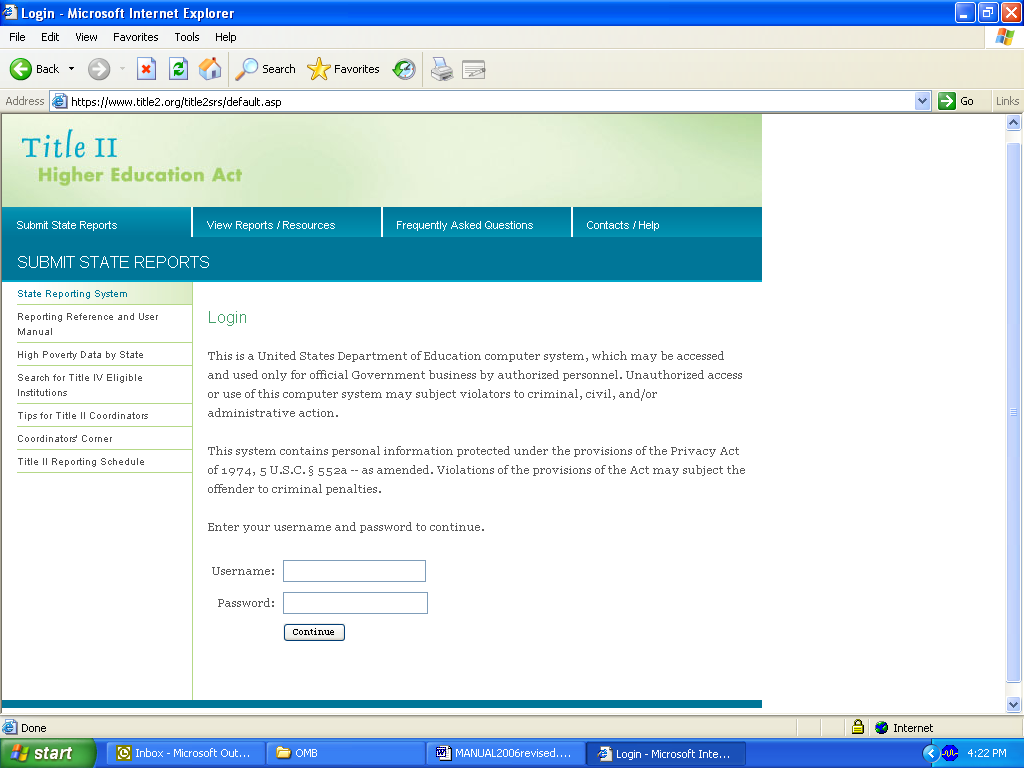
The first time you log into the SRS, you will be prompted to change your password (see Figure III.D.2). Your new password must meet the following requirements:
Must be 8-12 characters in length;
Cannot be part of your username;
Must contain at least one letter;
Must contain at least one number.
For example, a User ID of JonesB and password of Westat11 would be acceptable.
Figure III.D.2. Initial password change
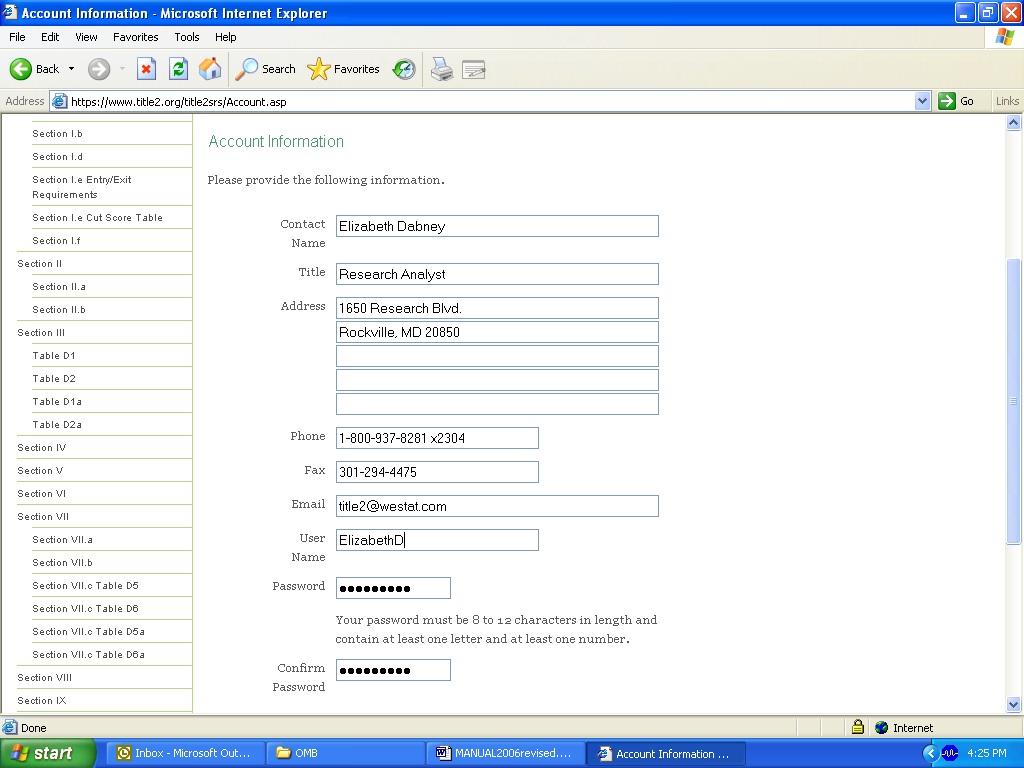
State
Reporting System to be updated upon approval of data collection
instrument
After you have successfully changed your password, click Save to proceed (See Section III Part E. System Features for help with the buttons).
During subsequent logins, if you enter an incorrect User ID and/or password, you will see a message stating, “The username/password supplied is incorrect. Please check it before trying again.” You may then re-enter the correct User ID and password to log in.
If you enter an incorrect User ID and/or password five times, you will be locked out of your account. This feature is for security purposes; however, it means that you will not be able to access your account. You must contact Westat to unlock your account.
If you do not remember your User ID and/or password, contact Westat. You will be issued a new User ID and/or password.
In the top right-hand corner and bottom right-hand corner of each page, you will see a link called Log out (see Figure III.D.3). Click on this link when you want to log out of the system. This will return you to the Login Page.
F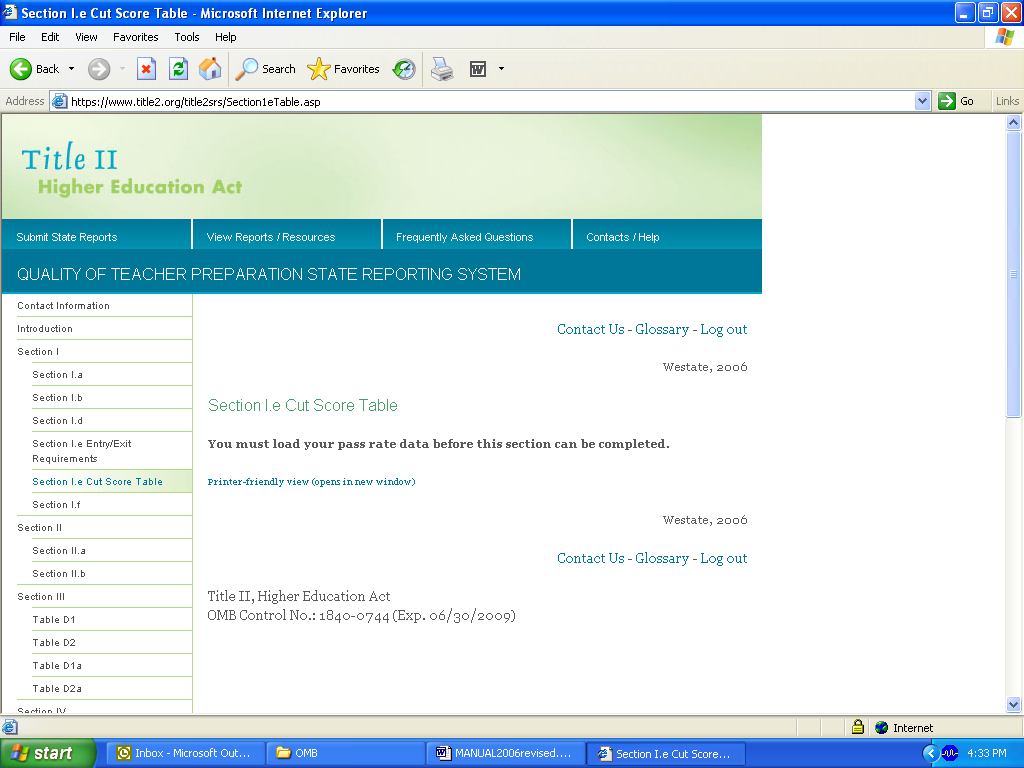 igure
III.D.3. Log out
igure
III.D.3. Log out
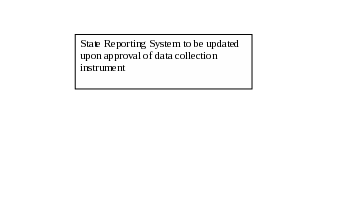
E. System Features
Radio buttons, text boxes, check boxes, Add/Edit/Delete options and buttons are found throughout the SRS.
Radio buttons. You may choose only ONE response when using radio buttons. To select a radio button, click on it with your mouse. Once a radio button is selected, the only way to deselect it is to choose another radio button in that response.
Text boxes. Single-line text boxes are usually limited to the size of the displayed box. Multi-line text boxes do not have a character limit; however, we encourage you to be brief, concise and to the point when entering text. When referencing a separate document, please refer to the document title in the text box, rather than copying the entire document into it. Email the actual document to us at [email protected]. When referencing a Web address, include the entire address (including “http://”). (See Figure III.E.1 for an example of radio buttons and text boxes.)
Figure III.E.1. Radio buttons and text boxes
Radio
buttons
Text
boxes
State
Reporting System to be updated upon approval of data collection
instrument


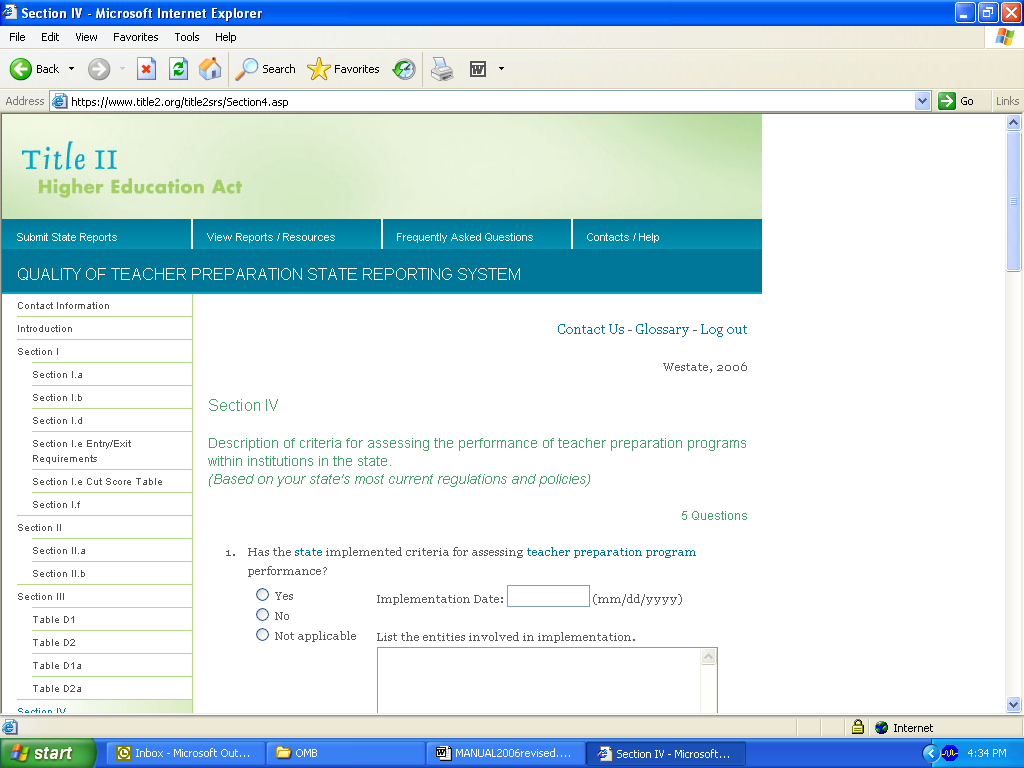
Check boxes. You may choose more than one check box in a single response (see Figure III.E.2). To select a check box, click your mouse in the box (or using the Tab key, tab to the box and press the space bar). To deselect a box, click your mouse in the box (or press the space bar) again.
Figure III.E.2. Check boxes
State
Reporting System to be updated upon approval of data collection
instrument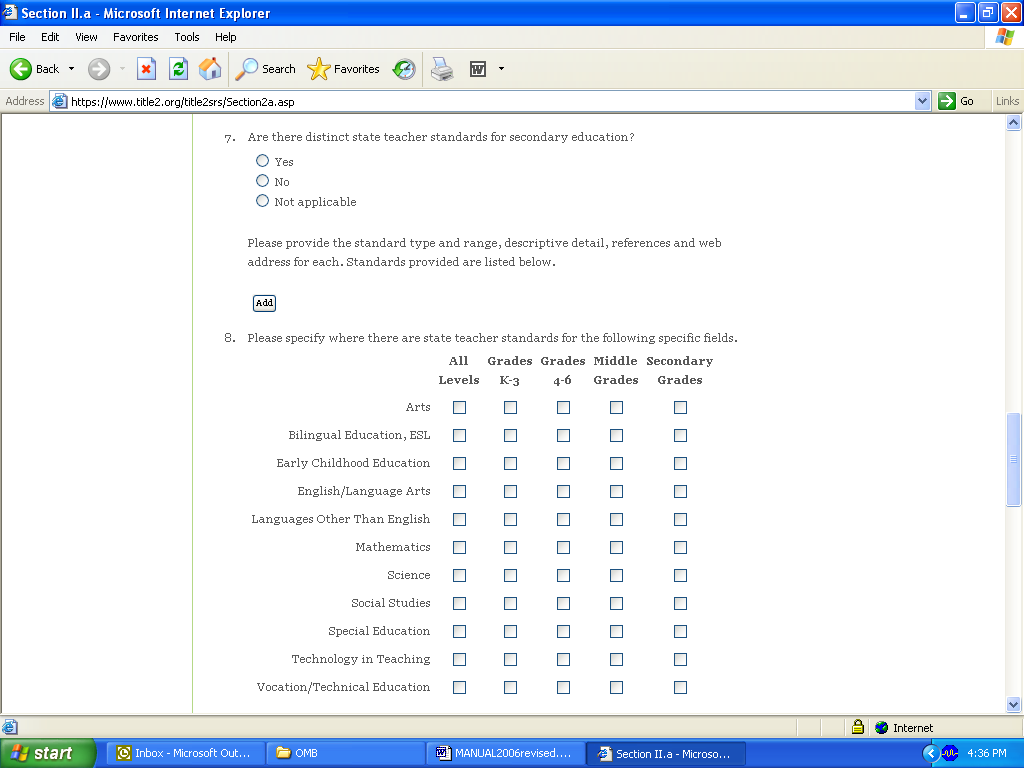
Add/Edit/Delete. We have preloaded most of your responses from last year. If your answers have not changed, you do not need to submit new responses. However, if you do need to update information, you will need to use the Add/Edit/Delete features, found throughout the SRS (see Figure III.E.3). To add new entries, click Add. To view or modify an existing entry, click Edit. To delete an entry, click Delete. You will see an alert box asking if you are sure you want to delete this item. Click on OK to delete the item, or click on Cancel if you do not want to delete the item.
Even if your answers have not changed from last year, we strongly recommend that you review them!
Figure III.E.3. Add/Edit/Delete
State
Reporting System to be updated upon approval of data collection
instrument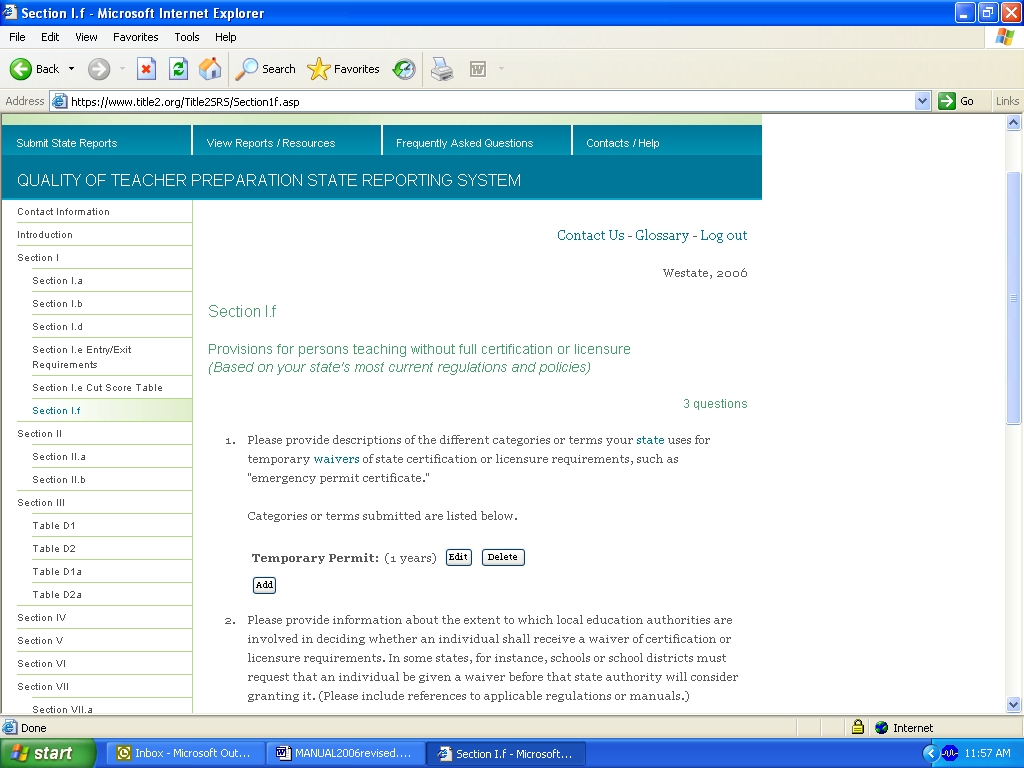
Some sections ask for a Web Address and/or Reference. Enter a Web address (including “http://”) if there is a related or corresponding Web site or page. Enter a document reference to direct a reader to a state publication, legislation, etc. (see Figure III.E.4).
Figure III.E.4. Reference and Web Address
State
Reporting System to be updated upon approval of data collection
instrument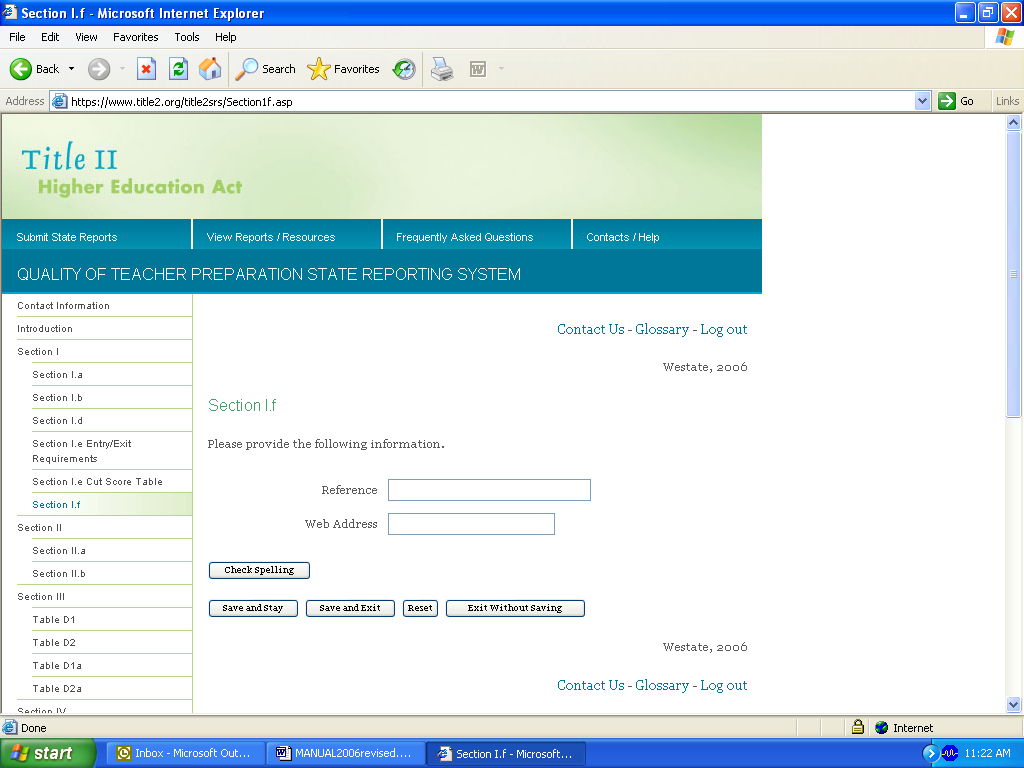
Buttons. One or more bottoms are at the bottom of each survey section. Please make special note of the following four buttons: Save and Stay, Save and Exit, Reset, and Exit Without Saving. A description of each is below.
Save and Stay: Selecting this button saves data in the section and keep you in that section. If you will be working on the same section for a lengthy time, we recommend that you save your data at least every 15 minutes (see Security). Use this button to save your data periodically as you work through a section.
Save and Exit: This button saves data in the section and returns you to the previous page or menu. Use this button when you want to exit a survey section. (If you have not completed the section, you can return to it later and your data will be saved.)
Reset: This button will reset all fields in the section to their last saved value. For example, if you make changes to a saved section but do not want to save the changes, use the Reset button. The section will return to how it appeared the last time you saved it.
Exit Without Saving: This returns you to the previous page or menu. Any changes made to the page since it was last saved will not be saved.
Check Spelling. A spell-check feature has been added to the report sections. If you want to check the spelling in a section, click on the button at the bottom of the page marked, "Check Spelling." A new window will open that lists spelling errors and suggests replacements. This feature is similar to those used in word processing programs. In order for the spell-check feature to work properly, your browser must allow pop-up windows. Please disable any pop-up blockers to use this feature.
Pop-Up Glossary. A pop-up glossary feature has been added to the report sections. If you want to check the definition of a word listed in the glossary, click on the words in blue throughout the survey. A new window will open that lists the definition of the word. If the glossary does not appear when you click on a linked word, please make sure your pop-up blocker is disabled for this site.
F. Report Navigation
Once you log into the SRS, you will be able to access all sections of the state report (see Figure III.F.1). You can access any section of the survey by clicking the links on the left side of the page. You can also access other information, such as the instructions and glossary.
Figure III.F.1. Main menu
State
Reporting System to be updated upon approval of data collection
instrument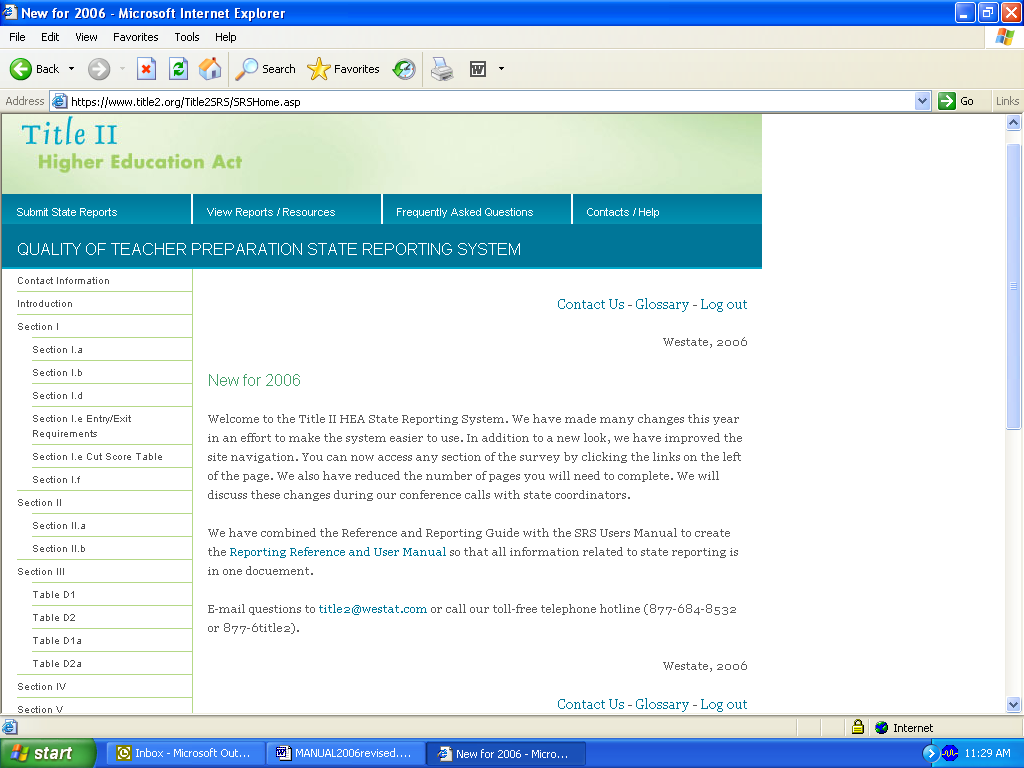
Contact Information
The individual listed in the Contact Information section (See Figure III.F.2) is presented as the state contact for members of the public who would like more information. The fields are fairly self-explanatory. If you need assistance entering or updating this information, contact Westat. The state Title II Coordinator may change or update this information at any time. Once you have entered information in the Contact Information section, choose the appropriate button (Save, Reset) at the bottom of the page (see Part III, Section E. System Features).
Figure III.F.2. Contact information
State
Reporting System to be updated upon approval of data collection
instrument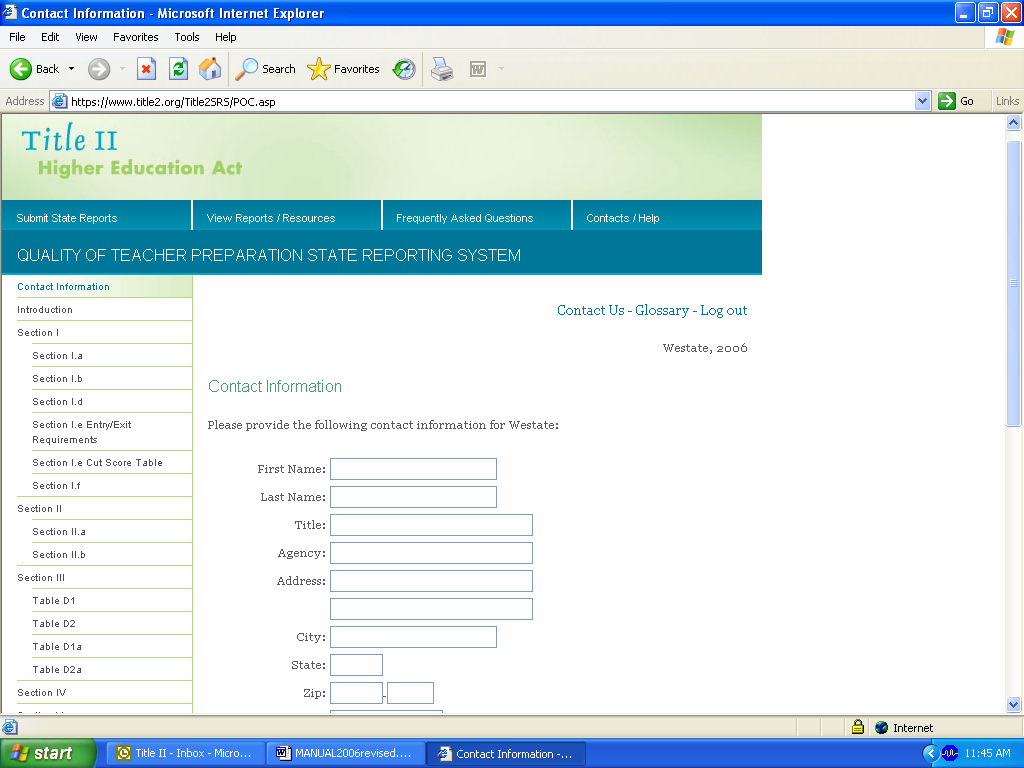
Section I: Description of State Teacher Certification or Licensure Assessments and Other Requirements
Please note that the questions in Section I.c. of the Reporting Reference and User Manual have been incorporated into Sections I.a., I.b., and I.d. of the on-line survey.
States are to provide information on degree, coursework, assessment, supervised teaching experiences and other requirements for each Type A/Level I, Type B/Level II and Type C/Level III certificate issued to teachers, as defined by the National State Directors of Teacher Education and Certification (NASDTEC). Type A/Level I certificates are issued upon completion of an approved teacher preparation program to an applicant who has met the requirements of the state, but has not completed ancillary requirements that must be met before issuance of a Type B/Level II certificate. Type B/Level II certificates are issued after the completion of an approved program and all ancillary requirements or after the completion of an alternative route program, all postsecondary degree and ancillary requirements and successfully completing not fewer than 27 months of professional employment in the function covered by the certificate. Type C/Level III certificates are issued after completion of all Type B/Level II certification requirements and any advanced requirements established by the state.
Sections I.a, b and d: Requirements to obtain Level I, II and III certificates
Click on the link for Section I. From the Section I page, you can complete Sections I.a, b, d, e & f of the survey (see Figure III.F.3). You can also access Sections I.a, b, d, e & f directly by clicking on the links at the left side of the page.
Figure III.F.3. Section I
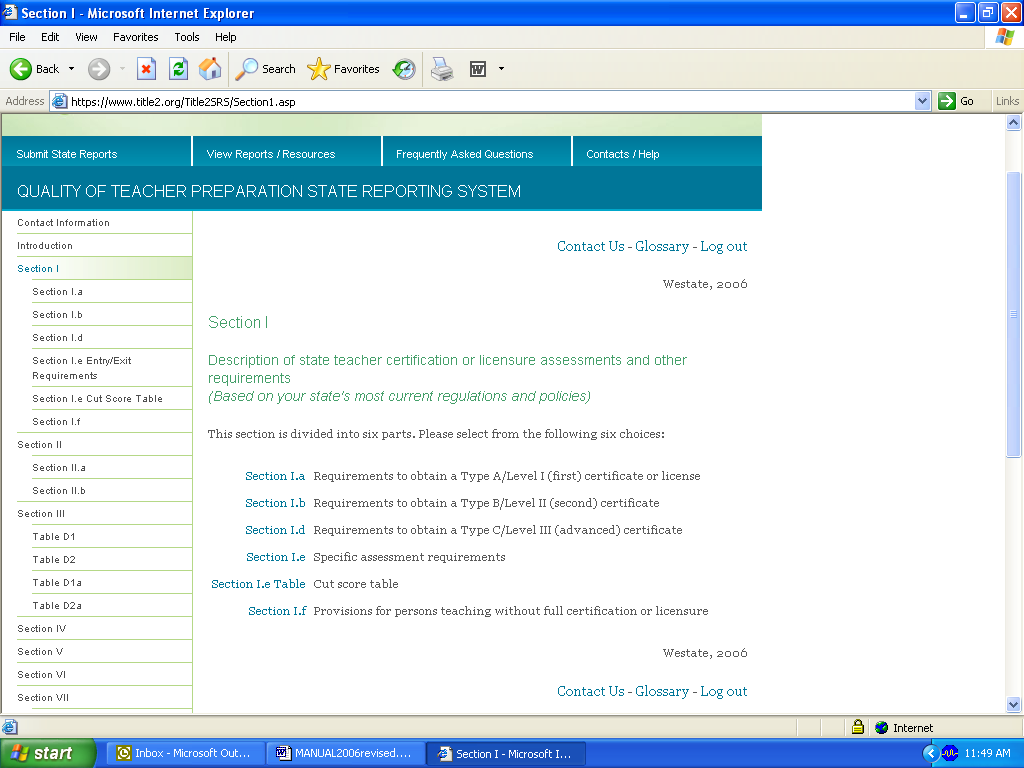
State
Reporting System to be updated upon approval of data collection
instrument
In these sections (see Figure III.F.4), you are asked to list the requirements to obtain a Type A/Level I (first), Type B/Level II (second) and Type C/Level III (advanced) certificate or license. These fields are prefilled with information your state Title II Coordinator entered during the last reporting year. Use the Edit button to review these entries carefully and update them as necessary. Information in this section should be based on your state’s most current regulations and policies.
Figure III.F.4. Sections I.a, b, and d
State
Reporting System to be updated upon approval of data collection
instrument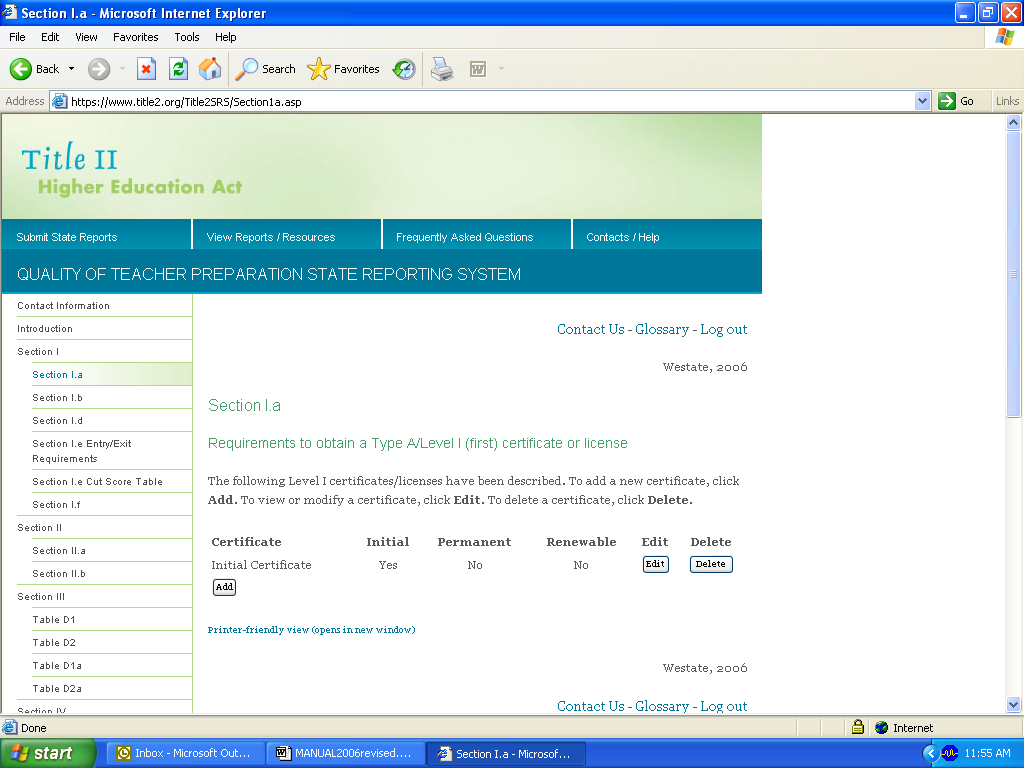
Section I.e: Specific assessment requirements and cut score table
Section I.e., Specific Assessment Requirements includes information on entry and exit requirements and an assessment cut score table (see Figure III.F.5). Institution and assessment names in this section are populated from the pass rate files, so this section is not available until your pass rate files are uploaded.
Figure III.F.5. Section I.e
State
Reporting System to be updated upon approval of data collection
instrument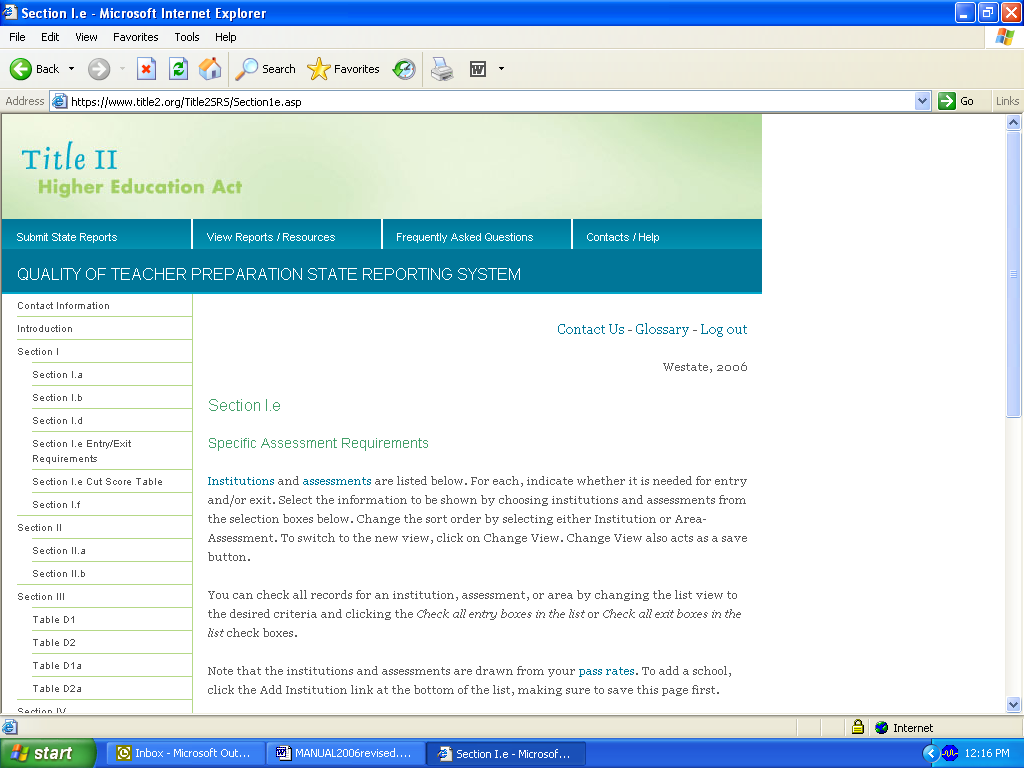
Sometimes 100 percent pass rates reflect institutional requirements. So that the public will understand these 100 percent pass rates, states are required to report those cases in which institutions require some or all of the assessments used for teacher certification or licensure to be taken either prior to admission to the program or as a condition of completion of or graduation from the institution’s teacher preparation program. Where these situations exist, institutions or states may want to provide supplementary descriptive information and measures that can give the public a better understanding of the performance of their teacher preparation programs.
To complete the requirement information, click on Section 1.e Entry/Exit Requirements on the left side of the page. You will see all of your state institutions and assessments listed (see Figure III.F.6). Indicate if each assessment is required for entry and/or exit at each institution by selecting the appropriate check boxes on the right-hand side of the page. If no tests are required for entry or exit at the institutional level, be sure to check the “No tests required for entry/exit” box on this page.
You may use the select boxes at the top of the page to limit what is shown on the page at one time. You may choose to view the following:
all or specific institutions,
all or specific assessment content areas, or
all or specific assessments.
You may also sort the information by institution or assessment. To do this, select the appropriate radio button (Institution or Assessment). After you have made your selections, click on the Change View button.
By using the select and sort boxes, you can make global selections on this page. For example, if all basic skills tests are required for entry at all institutions, show all institutions, the basic skills area and all assessments. Then check the “Check all entry boxes in the list” box. This will check the entry box for all assessments listed on the page.
After you have selected the appropriate check boxes to indicate if the assessment is required for entry or exit at that institution, choose the appropriate button at the bottom of the page: Save or Reset (see Part III Section E. System Features).
Figure III.F.6. Section I.e Requirements
State
Reporting System to be updated upon approval of data collection
instrument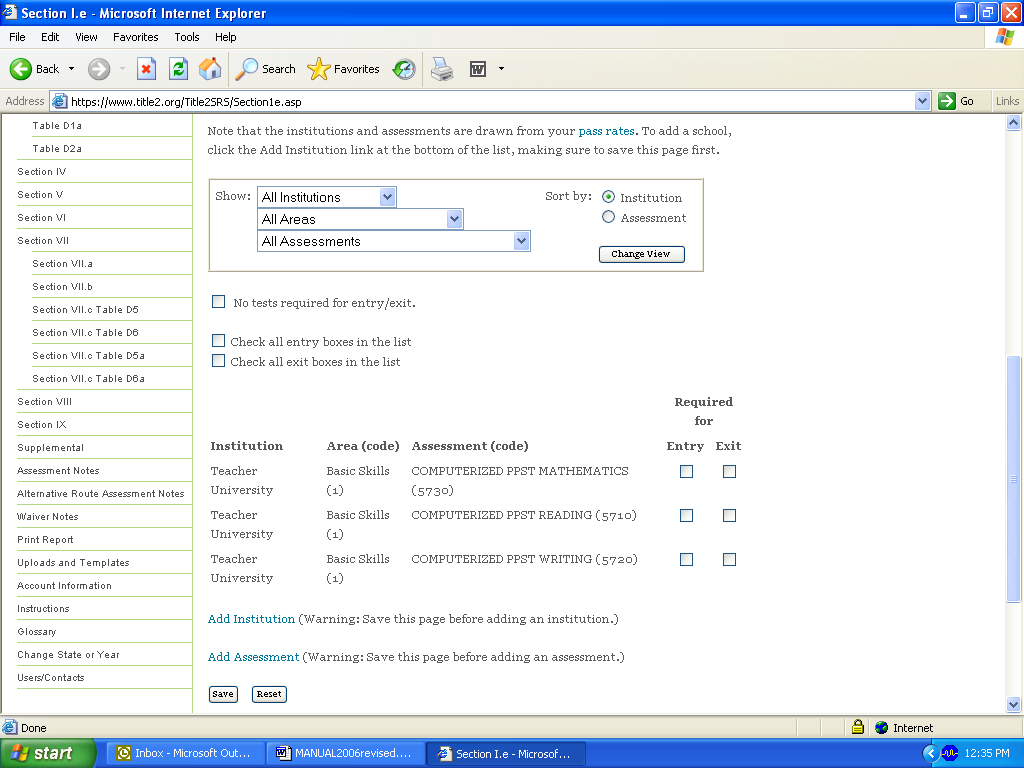
To complete the Section I.e table, click on Section I.e Cut Score Table on the left side of the page (see Figure III.F.7). This section will not be populated until your pass rate files have been uploaded.
Test area and assessment name will be preloaded on the screen from the pass rate files.
For each test reported in your pass rate files, please provide the state minimum cut score and the lowest and highest possible score.
You may add an assessment by clicking on the “Add Assessment” link at the bottom of the page. When you click on this link, you will need to enter an area code, assessment code and assessment name. Be sure to save your information before moving to another section of the survey.
Figure III.F.7. Section I.e Cut Score Table
State
Reporting System to be updated upon approval of data collection
instrument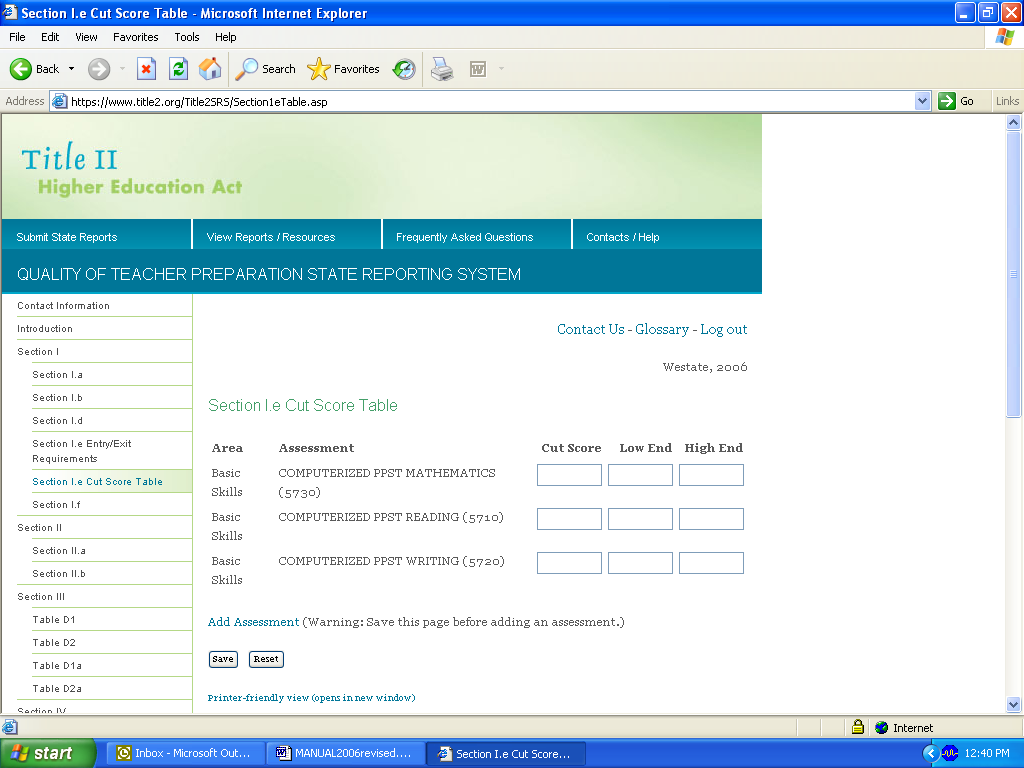
Section I.f: Provisions for persons teaching without full certification or licensure
On the left side of the page, click on the appropriate link for Section I.f. (see Figure III.F.8). These fields are prefilled with information your state Title II Coordinator entered during the last reporting year. Use the Edit button to review these entries carefully and update them as necessary. Information in this section should be based on your state’s most current regulations and policies.
Figure III.F.8. Section I.f
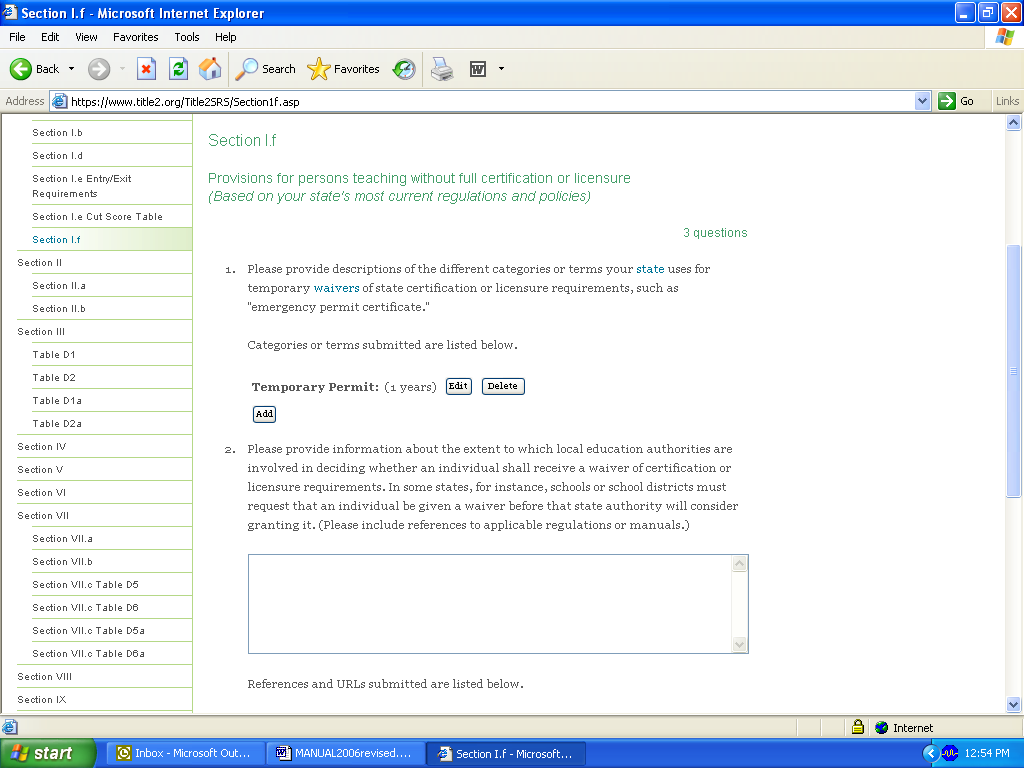
State
Reporting System to be updated upon approval of data collection
instrument
Section II: Description of State Teacher Standards and the Alignment Between State Teacher Certification or Licensure Requirements and Assessments and State Student Standards and Assessments
Section II (see Figure III.F.9) is divided into two parts. The first part asks about standards and criteria; the second is concerned with policy. Select the appropriate link to complete Section II.a or Section II.b. Information in both sections should be based on your state’s most current regulations and policies.
Figure III.F.9. Section II
State
Reporting System to be updated upon approval of data collection
instrument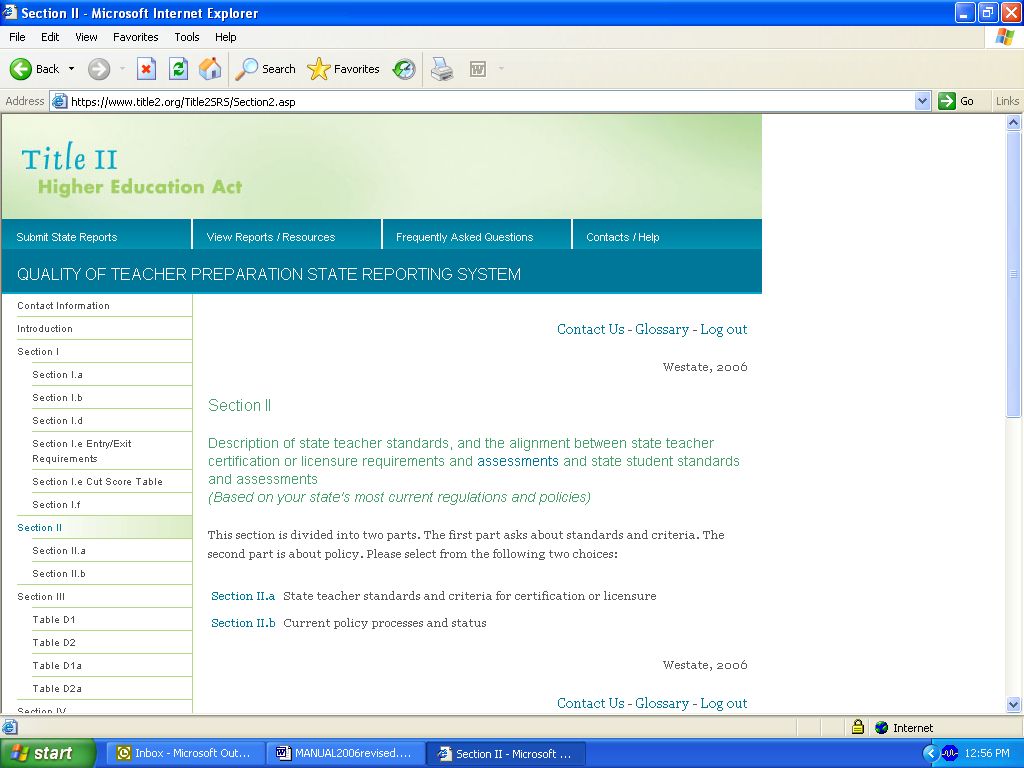
Section III: Statewide and Institutional Pass Rates
States will receive reports containing pass-rate information from all institutions. States also will identify alternative route programs and will develop procedures for the receipt of pass-rate data for completers of each of these programs.
States will determine who will calculate the data needed to report on statewide pass rates. For example, some states may have files of data that will allow them to generate pass rates. Other states will work with testing companies to determine when, and in what form, data will be received that will allow the states to generate pass rates.
On the left side of the page, click on the link for Section III (see Figure III.F.10). You must also report updated pass rate data for your cohort based on information available in the third year of a cohort (3rd Year Cohort Update) (Tables D1a-D2a). This section includes Tables D1 and D2 and Tables D1a and D2a. These tables are:
D1: State-Level Single Assessment Pass-Rate Data for Traditional Teacher Preparation Programs Within Institutions of Higher Education, by Institution
D2: State-Level Summary Assessment Pass-Rate Data for Traditional Teacher Preparation Programs Within Institutions of Higher Education, by Institution
D1a: State-Level Single-Assessment Pass-Rate Data for Traditional Teacher Preparation Programs Within Institutions of Higher Education, by Institution
D2a: State-Level Summary Assessment Pass-Rate Data for Traditional Teacher Preparation Programs Within Institutions of Higher Education, by Institution
Complete Section III.a. at the top of the page. Be sure to save your work before moving on to the tables, which are located lower on the page.
Figure III.F.10. Section III
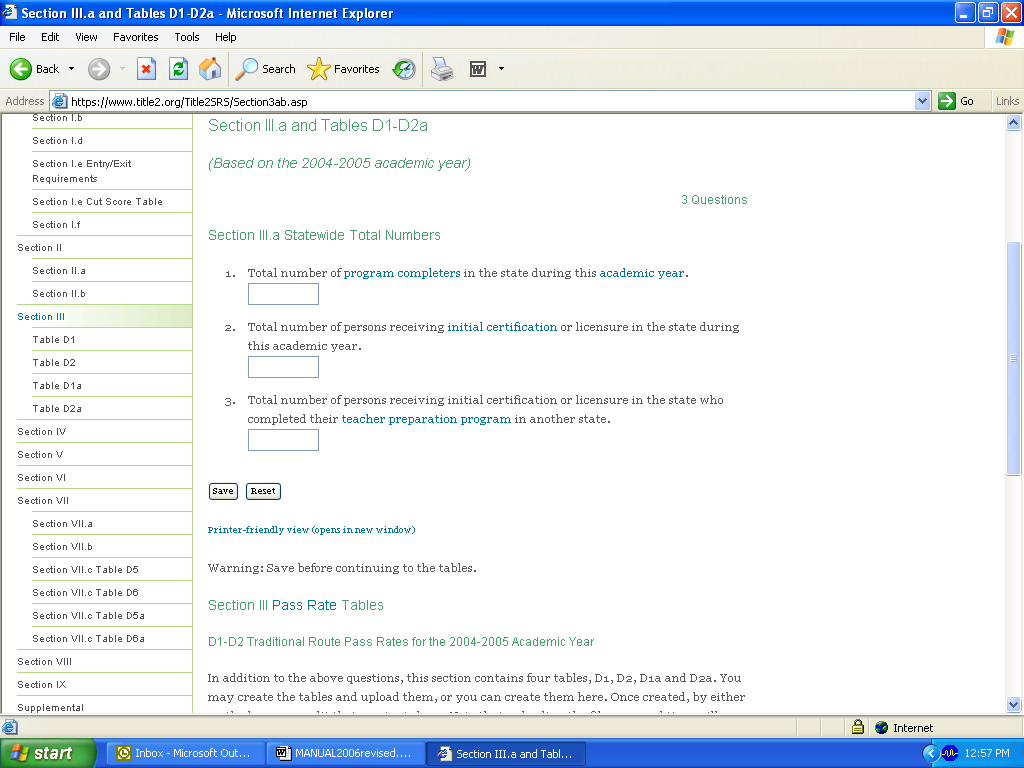
State
Reporting System to be updated upon approval of data collection
instrument
After saving Section III.a., scroll down the page to complete Tables D1 and D2 and Tables D1a and D2a (see Figure III.F.11). You may download, complete and upload the tables using the Uploads and Templates feature on the left side of the page (see Uploads and Templates) or you may enter the data for these tables here. After the tables are created (whether uploaded or entered here), you can then access and edit the tables using the links on this page.
Figure III.F.11. Tables D1-D2 and Tables D1a-D2a
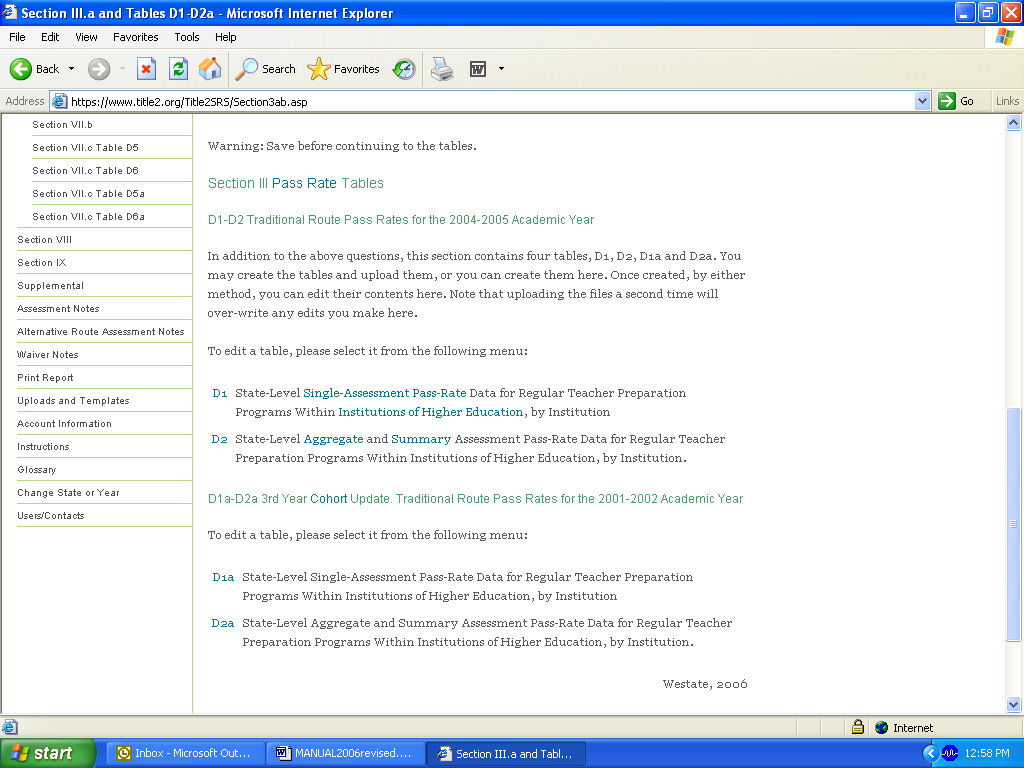
State
Reporting System to be updated upon approval of data collection
instrument
Click on the appropriate link for the table you want to edit or enter. If the table has been previously uploaded, you will see the table entries listed (see Figure III.F.12). If the table has not been uploaded, you will see the table header only.
Figure III.F.12. Entering or editing a table
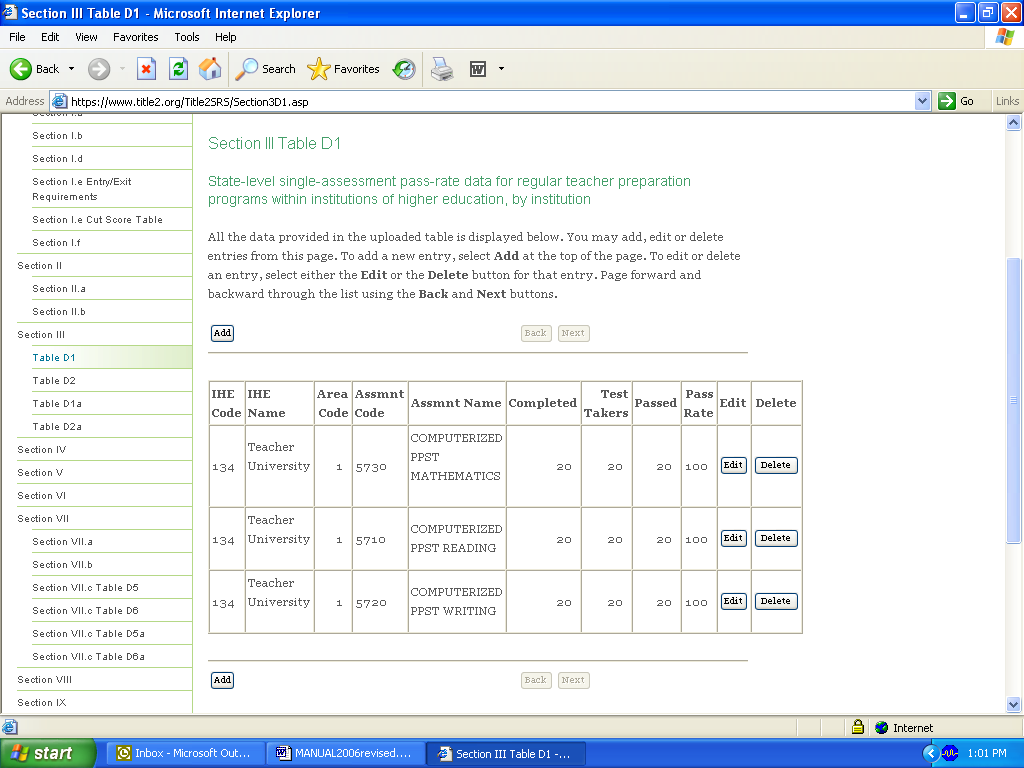
State
Reporting System to be updated upon approval of data collection
instrument
To add a new table entry, click on the Add button. This will take you to another screen. Depending on the table you are editing or entering, you will see drop-down lists and links for Add Institution, Add Assessment and Add Program (see Figure III.F.13). Click on a link to add information or choose the appropriate item from the associated drop down list. See Section III Part E. System Features for help with text boxes and the buttons at the bottom of the screen.
If the table has been previously uploaded, review the data and edit them as necessary. To edit an entry, click on the Edit button to the left of the entry. To delete an entry, click on the Delete button to the right of the entry. You will see an alert box asking if you really want to delete the entry. To delete the entry, click OK. If you do not want to delete the entry, click Cancel.
If the table is more than one page, use the Next and Back buttons at the top or bottom of the table to page forward and backward. These buttons will appear gray and will be inoperable if the table is only one page.
Figure III.F.13. Adding a table item
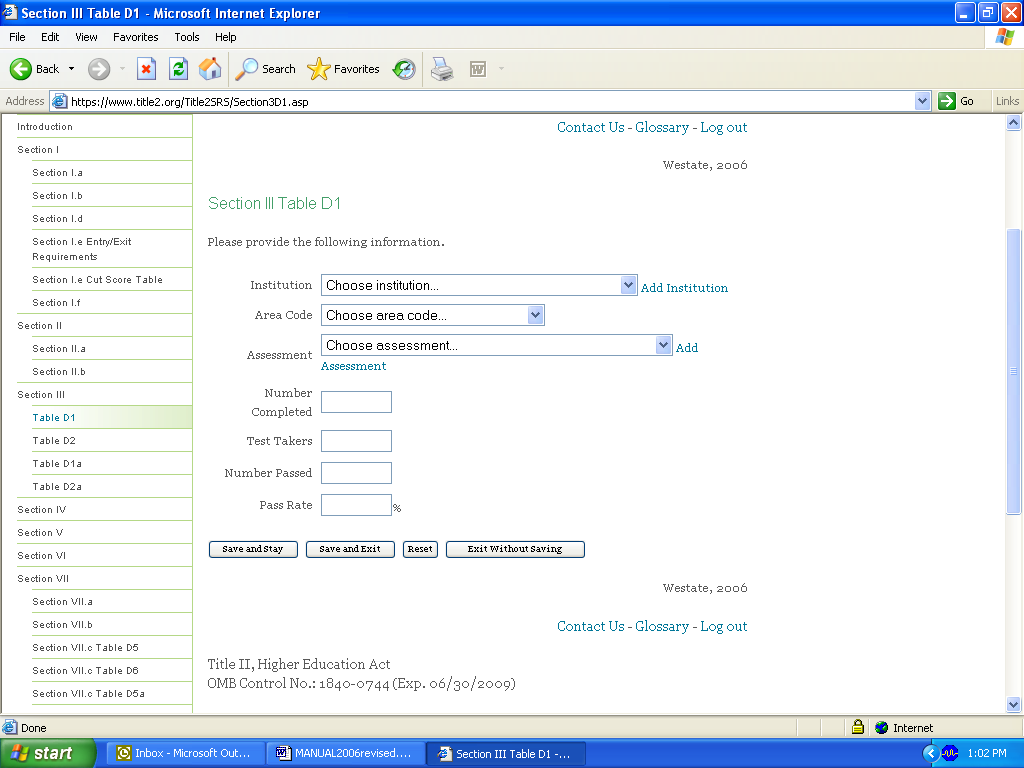
State
Reporting System to be updated upon approval of data collection
instrument
Section IV: Description of Criteria for Assessing the Performance of Teacher Preparation Programs Within Institutions in the State
From the left side of the page, click on the link for Section IV (see Figure III.F.14). Information in this section should be based on your state’s most current regulations and policies. See Section III Part E. System Features for help with radio buttons and text boxes. Please be concise and brief when entering data in text boxes. If you have a large amount of text to enter, you may email us a separate document (at [email protected]) and refer to the document in the text box. You may also refer to Web addresses in the text boxes.
Please note that in Question 1, if you answer Yes, you must enter an Implementation Date. If you answer No, you cannot enter an Implementation Date. To enter a valid Implementation Date, use the format: mm/dd/yyyy.
Figure III.F.14. Section IV
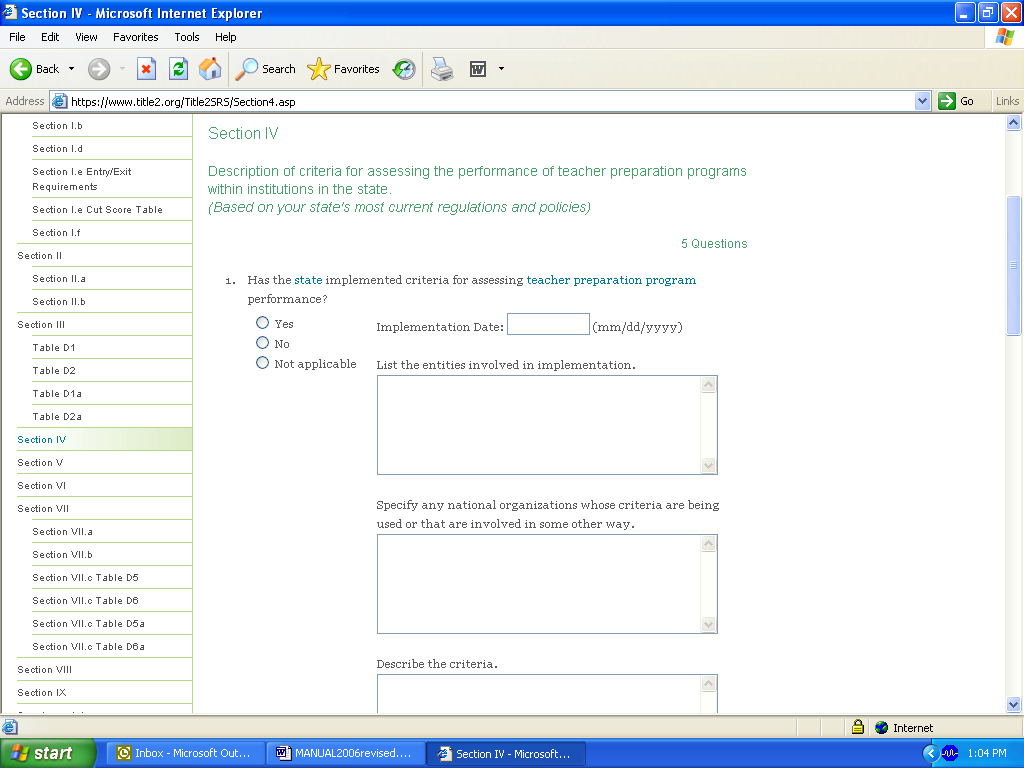
State
Reporting System to be updated upon approval of data collection
instrument
Section V: List of Low-Performing State Teacher Preparation Programs
On the left side of the page, click on the link for Section V (see Figure III.F.15). Items in this section should be answered with information as of the most current review cycle. See Section III Part E. System Features for help with text boxes. Please be concise and brief when entering data in text boxes. If you have a large amount of text to enter, you can email us a separate document (at [email protected]) and refer to the document in the text box. You can also refer to Web addresses in the text boxes.
If you listed any at-risk or low performing teacher preparation programs last year, they will be listed in Question 3. Please indicate whether the program is still classified as low performing or at-risk of being so classified.
In Question 4, when adding a new teacher preparation program, use this date format: mm/dd/yyyy. If you do not follow this format, you will see an alert box stating that the date is invalid. Do not answer Question 4 if you have not identified any institutions as low-performing or at-risk of becoming low-performing.
Figure III.F.15. Section V
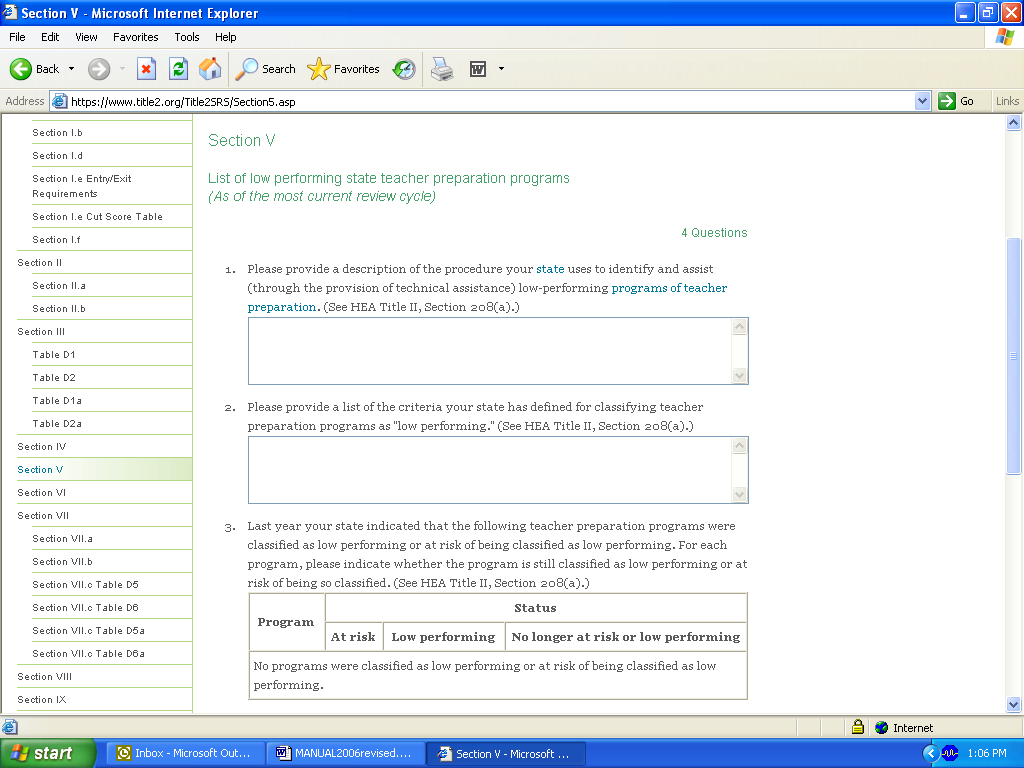
State
Reporting System to be updated upon approval of data collection
instrument
Section VII: Alternative Routes to Teacher Certification or Licensure, and Pass Rates for Program Completers of Alternative Routes
From the left side of the page, click on the link for Section VII (see Figure III.F.17). After completing Question 1, save this section before moving on.
Save Section VII after completing question 1 and before moving on to the remainder of the section. Please note that links for Sections VII.a, VII.b and VII.c. (Tables D5, D6, D5a and D6a) are located on the same page as Section VII, Question 1. You will see them as you scroll down the page.
Figure III.F.17. Section VII
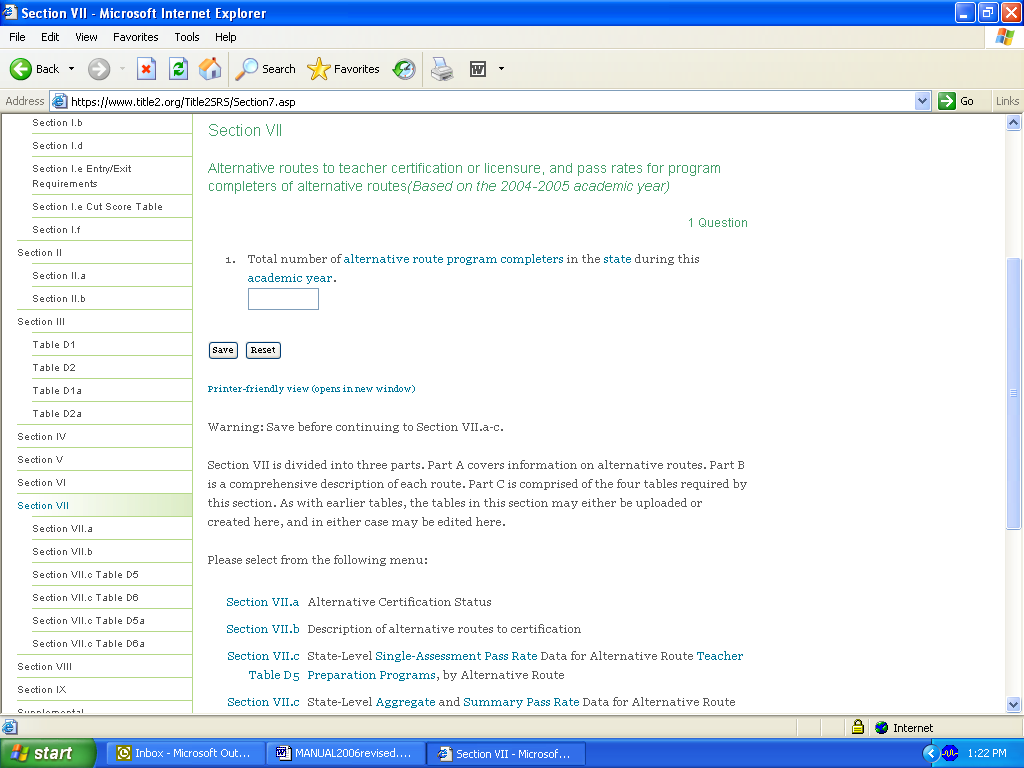
State
Reporting System to be updated upon approval of data collection
instrument
The remainder of Section VII is divided into several parts. Section VII.a deals with alternative certification status. Section VII.b collects descriptions of alternative routes. Section VII.c comprises Tables D5, D6, D5a and D6a and collects pass rate data for alternative routes.
To complete Section VII.a, click on the appropriate link. Information in this section should be based on your state’s most current regulations and policies. See Section III Part E. System Features for help using radio buttons.
To complete Section VII.b, click on the appropriate link. Here, you will describe each alternative route to certification, based on your state’s most current regulations and policies. If your state Title II Coordinator entered this information for the last reporting year, these data will be prefilled. To add a new route, click on the Add button. To edit a route already listed, click on the Edit button. To delete a route, click on the Delete button.
For each alternative route, please provide the following information:
Alternative route or program name;
Recruitment details;
Selection process description;
Program of study;
Practice teaching details and hours;
Assessments required;
Private support details;
Names of institutions or entities offering the program; and
Administration details.
Question 10 of Section VII.b. lists institutions offering each alternative route. This list is automatically generated after Tables D1 and D2 have been entered. To add an institution, click on the Add Institution link.
To complete Section VII.c (Tables D5, D6, D5a, D6a), click on the appropriate link. If the table has been previously uploaded, you will see the table entries listed (see Figure III.F.18). If the table has not been uploaded, you will see the table header only. To add a table entry, click on the Add button. Depending on the table you are editing, you will see drop-down lists and links for Add Program and Add Assessment (see Figure III.F.13). Click on a link to add information or choose the appropriate item from the associated drop down list. See Part III Section E. System Features for help with text boxes and the buttons at the bottom of the screen. If you have more than one entry to add, click on the Save and Stay button at the bottom of the page and enter the data for your next item.
Figure III.F.18. Table D5
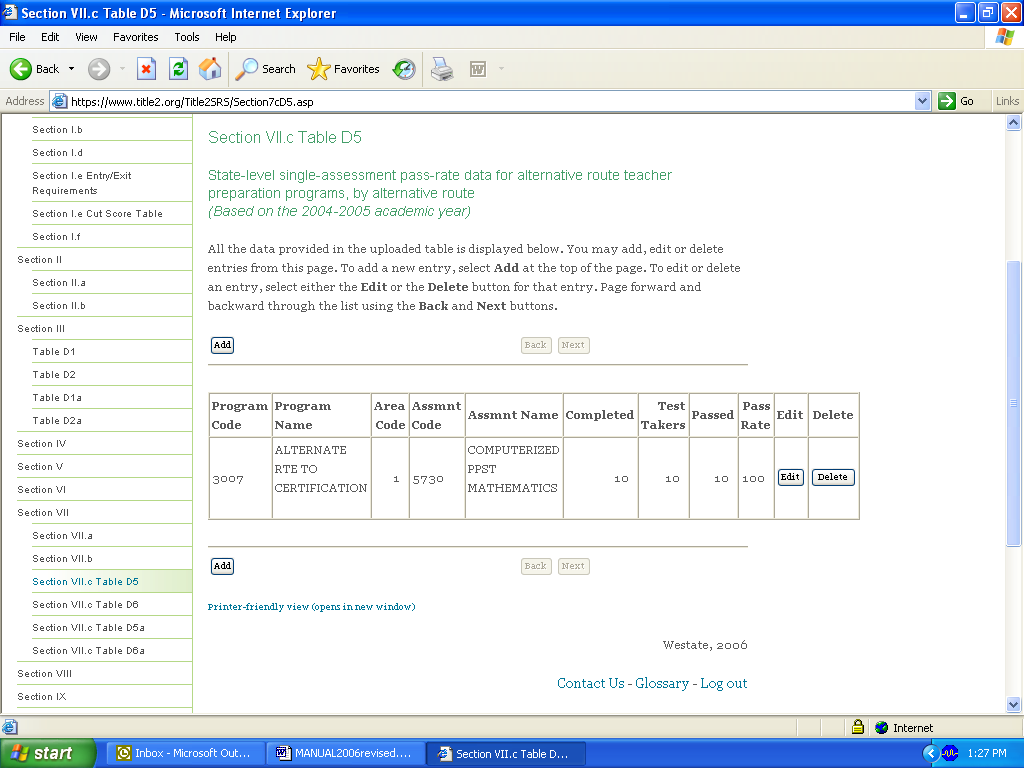
State
Reporting System to be updated upon approval of data collection
instrument
If the table has been previously uploaded, review the data and edit them as necessary. To edit an entry, click on the Edit button to the left of the entry. To delete an entry, click on the Delete button to the right of the entry. You will see an alert box asking if you really want to delete the entry. To delete the entry, click on OK. If you do not want to delete the entry, click on Cancel.
If the table is more than one page, use the Next and Back buttons at the top of the table to page forward and backward. If the table is only one page, these buttons will appear gray and will be inoperable.
Section VIII: State Efforts To Improve Teacher Quality
From the left side of the page, click on the link for Section VIII (see Figure III.F.19). Question 1 of Section VIII should be prefilled with information entered during the previous reporting year. Please review this information and edit it as necessary. Please be as concise as possible when entering or editing text. If you have large amounts of text to enter, you may refer to a separate document in the text box and email the document to us at [email protected].
Figure III.F.19. Section VIII
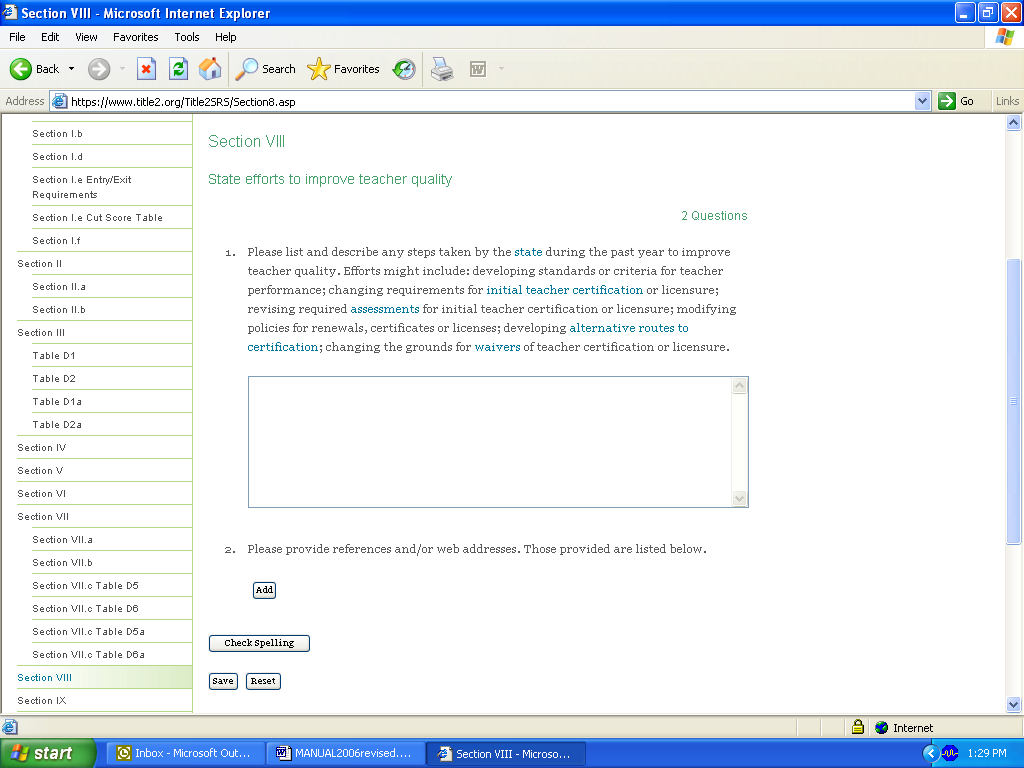
State
Reporting System to be updated upon approval of data collection
instrument
Section IX: Certification
From the left side of the page, click on the link for Section IX. Upon entering this section, the SRS will run a check to be sure the report is complete. If the report is not complete, the system will present the questions that have been left unanswered (see Figure III.F.20).
Data editing features have been implemented to assist you in ensuring the quality and accuracy of the information being reporting. For example, you will see a report on the percentage change in the number of teachers on waivers for the current and prior year.
The expanded data verification report, which provides edit check information, is always available in Section IX; you do not need to certify in order to view the report.
Figure III.F.20. Certification verification
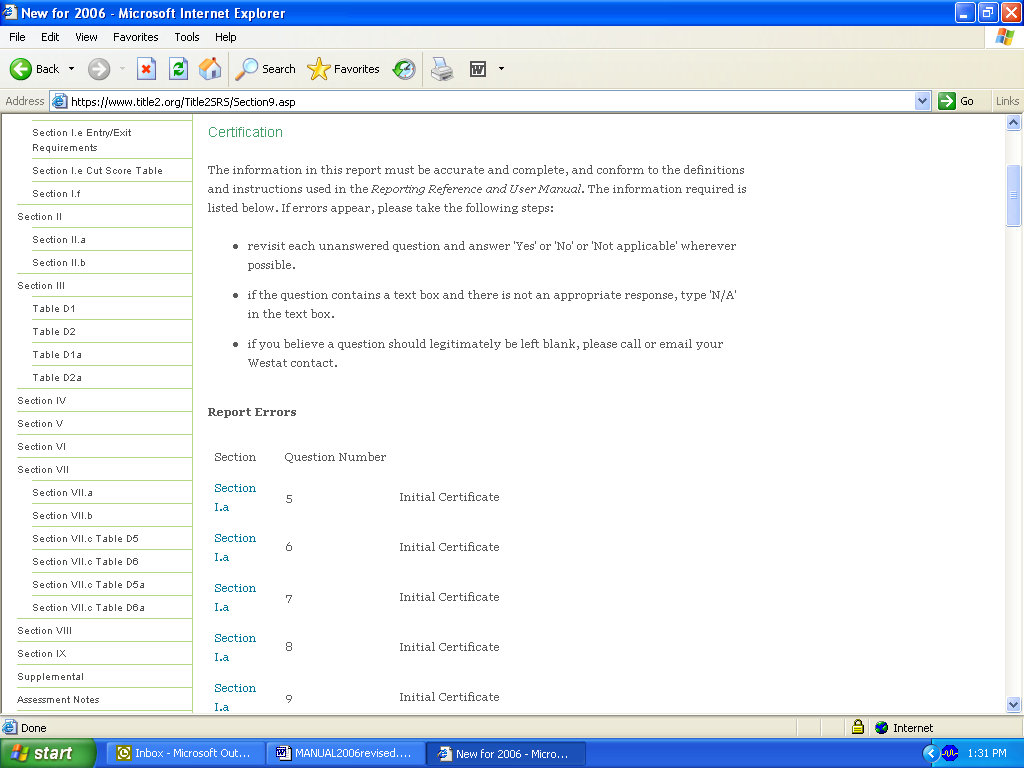
State
Reporting System to be updated upon approval of data collection
instrument
You must resolve all outstanding issues listed in Section IX before certifying your data. If your report includes errors (i.e., unanswered questions), follow these instructions, which are listed at the top of Section IX:
Revisit each unanswered question and answer ‘Yes’ or ‘No’ or ‘Not applicable’ wherever possible.
If the question contains a text box and there is no appropriate response, type ‘N/A’ in the text box.
If you believe a question should legitimately be left blank, call or email your Service Center contact.
When all sections of the report have been completed, the state Title II Coordinator will select the check box in the Complete field (see Figure III.F.21). Checking this box indicates that the report is complete and that the information in the report is accurate and conforms to the definitions and instructions used in the Reporting Reference and User Manual. (The manual can be found on the Title II Web site at www.title2.org.) When the box is checked, the data collection system will automatically send the state coordinator an email indicating that the certification process is complete. In order for the email verification of data certification to work properly, your browser must allow pop-up windows. Please disable any pop-up blockers to use this feature. In addition, the report will be locked and the Coordinator will no longer have access to it.
Figure III.F.21. Certification
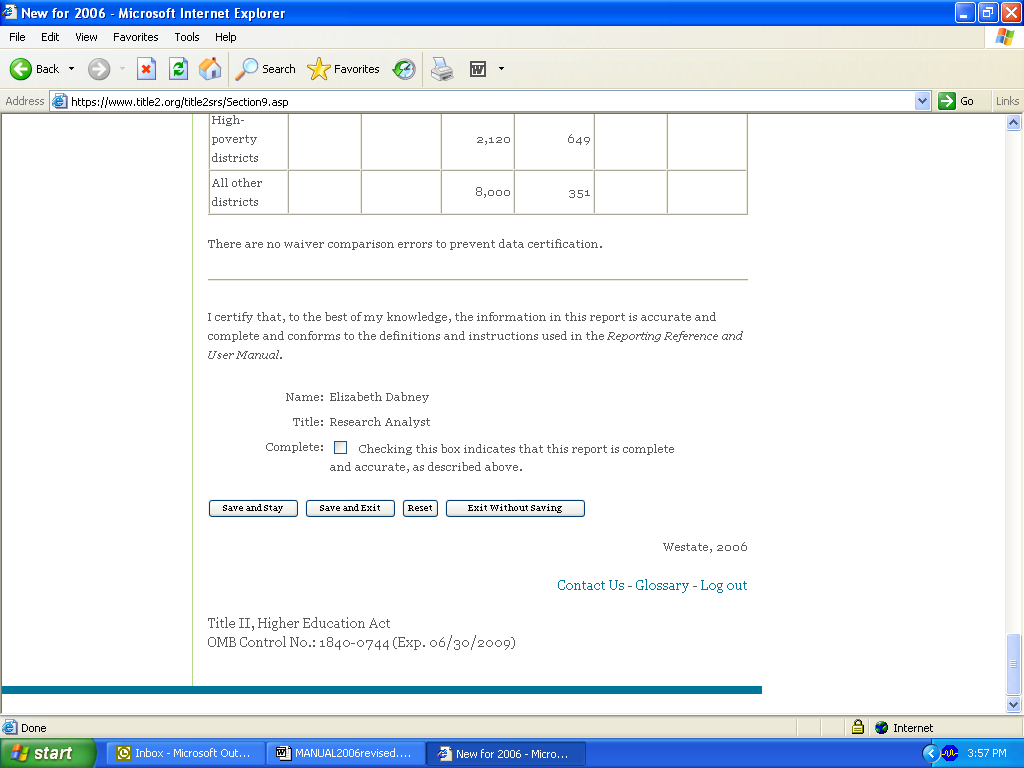
State
Reporting System to be updated upon approval of data collection
instrument
Printing Your State Report
From the left side of the page, click on the Print Report link. From here (see Figure III.F.22), you may print your complete report. To print the report, use your browser print function. For example, if you are using Internet Explorer, you should see a Print button at the top of your browser window. Click on this button to print the report or click on File from the menu at the top of the screen and then choose Print.
While you can print the entire report at once, we recommend that you print each section separately. Each section has a “printer-friendly view” link at the bottom of the page that opens a new window. Depending on your window or browser settings, some sections (Section III, for example) will print better in landscape format. Also, many of the sections can be quite lengthy—particularly Section I.e. and Section III. Printing the entire report at once may take several minutes.
Figure III.F.22. Print menu
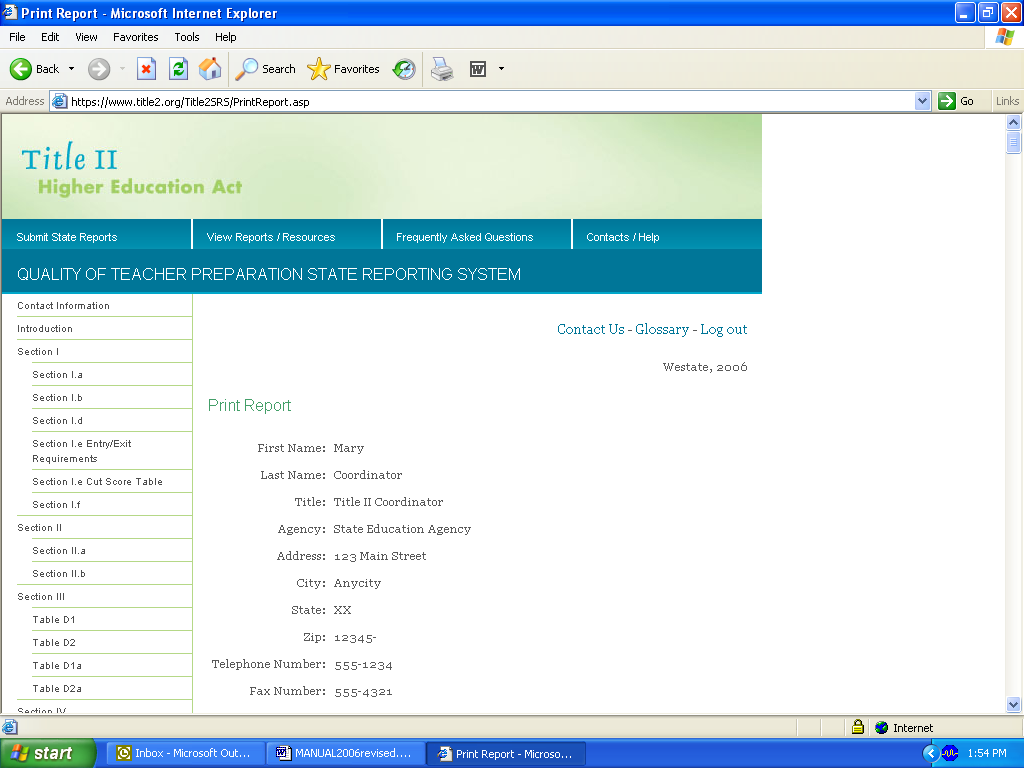
State
Reporting System to be updated upon approval of data collection
instrument
Uploads and Templates
We would prefer that you email your pass rate files to Westat for uploading. Please email your files to your designated Westat contact. If you choose to upload your own files, follow the instructions below. If you should need technical assistance, contact Westat.
Uploads
From the left side of the page, click on the Uploads and Templates link. You may upload the following files using the Upload tool provided here (see Figure III.F.23): Tables D1, D2, D5, D6, D1a, D2a, D5a, D6a and unmodified ETS report files.
In the text box, type in the path to an individual file, or click on the Browse button to select a file to upload. Be sure to select all the files you wish to upload and upload all the files of one type at once. You must also specify the file type by clicking on the appropriate radio button below the text box. The file type must be one of the following:
File(s) provided by ETS for a traditional program within an IHE;
File(s) provided by ETS for a traditional program within an IHE, Third Year Cohort Update;
File(s) provided by ETS for an alternative route program;
File(s) provided by ETS for an alternative route program, Third Year Cohort Update; or
File(s) in .csv (comma separated values, similar to an Excel file) format for Tables D1 through D6, Tables D1a and D2a and Tables D5a and D6a.
Use the .csv format if you are not using the standard files provided by ETS or Pearson/ES. See Templates for instructions on downloading files in this format.
Figure III.F.23. Uploads
State
Reporting System to be updated upon approval of data collection
instrument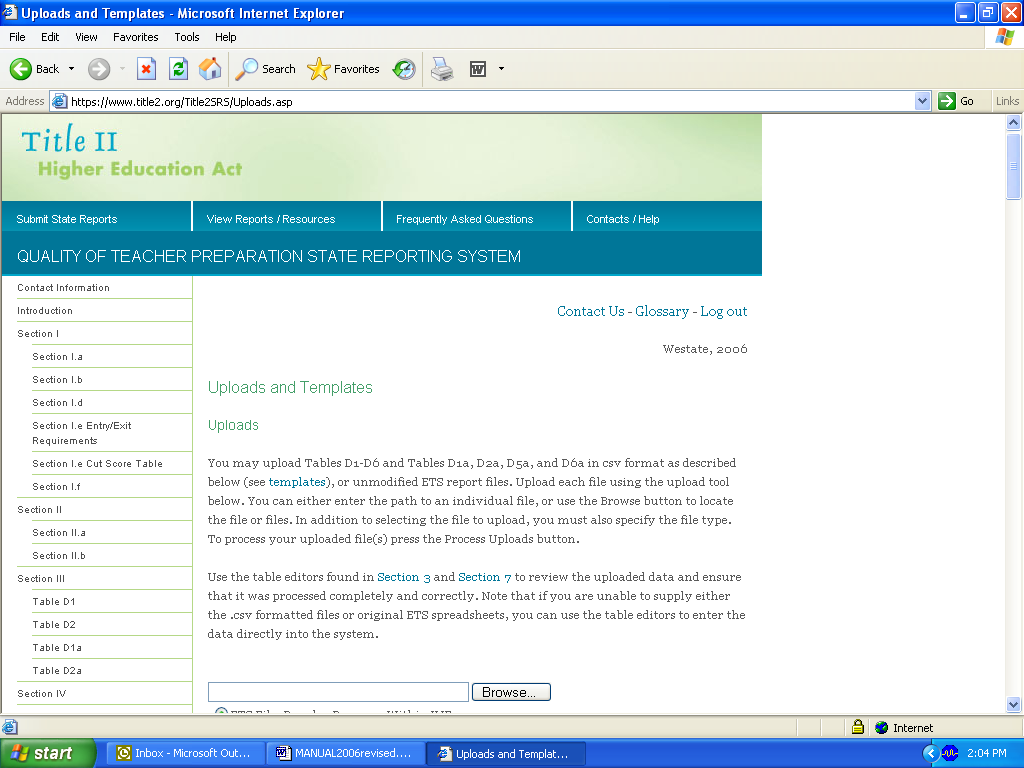
Once you have chosen all the files to upload and specified the file type, click on the Send File button to upload all the files.
If each of the files is successfully uploaded, you will see a message stating, “Upload of (file name) was completed successfully.”
Once all of the files are uploaded, click on the Process Uploads button. You should see a message that states that each uploaded file was processed and logged.
Once your files have been uploaded, go to the appropriate section (Section III or VII) of the system to be sure the data were uploaded correctly. If the data were not uploaded correctly, you can enter the data in the appropriate section or contact Westat for assistance.
For additional help on preparing your pass rate files, please see Pass Rate Tips below.
Title II Technical Assistance
Pass Rate Tips
PASS RATES: The loaded pass rates in Tables D1 and D2 will automatically populate survey Table I.e. (the cut score table), Section I.e. (entry/exit requirements), and Section VII.b. (IHEs with alternative routes). Please send us or upload your pass rate files as soon as possible.
Pass rate files will undergo rigorous system checks as they are uploaded. Any errors will be reported immediately to the user in an error message. To avoid some of these errors, please review the checklist below before submitting or uploading pass rate files. |
Check List
Files must be in ETS or NES format or match the templates provided on the Web-based system (Section III for traditional routes and Section VII for alternative routes).
If you use the templates provided on the Web-based system (Sections III and VII), the files CANNOT contain any commas. Make sure that the institutional name and assessment name fields do not contain commas.
IHE Codes [IHECode] (Institution of Higher Education) are required for traditional route pass rate Tables D1, D2, D1.a, and D2.a. IHE Codes must be unique to each institution.
Program Codes [ProgCode] are required for alternative route pass rate Tables D5, D6, D5.a, and D6.a. Programs may be institutions or they may be outside of IHE’s; they should also be unique. You cannot use the IHE codes from Tables D1-D2 in this field.
Both IHE and Program codes should match the codes used in prior years.
IHE Names [IHEName] are required for traditional route pass rate Tables D1, D2, D1.a, and D2.a.
Program Names [ProgName] are required for alternative route pass rate Tables D5, D6, D5.a, and D6.a.
Please check the IHE Names and Program Names to ensure uniformity. Verify that the names are spelled properly. If you use abbreviations, make sure they are used consistently.
The Assessment Code [AssessmentCode] and Assessment Name [AssessmentName] must be unique to each test. They also should match the codes and names given by the testing companies and/or your state. Frequently we see incomplete names (for example, Biology rather than Biology Content Knowledge) or inconsistent assessment codes.
The number of test takers [Takers] must be a number equal to or greater than zero, even if it is fewer than 10. If the record is left blank, it will not be loaded.
The number of completers passing [Passed] should be blank if it is fewer than 10. It must also be less than or equal to the number of takers.
The pass rate [Passrate] should be blank if there are fewer than 10 test takers. It should be equal to the number of passers divided by the number of takers.
There must be a Table D2 record for every school listed in D1. Table D1 collects individual assessment information at the IHE level, and D2 collects this IHE information at the aggregate area code level. All schools with assessment information in D1 must be aggregated and listed in D2. This is also the case with D5 and D6, D1.a and D2.a, and D5.a and D6.a.
There must be a D2 (or D2.a) statewide record for each area tested in D1 (or D1.a).
There must be a D1 (or D1.a) statewide record for each assessment in D1 (or D1.a).
There must be a statewide record for each aggregate area code in D6 and D6.a.
If you are using the templates provided on the system, the statewide summary records must use the IHE or Program Code 9999. State summary records must be named “Statename Summary” (Alabama Summary, for example).
Templates
Data templates (preformatted Excel spreadsheets) are provided for you to help you report pass rates and other data. Think of these as a library of spreadsheets that have been developed for Title II. These templates are provided in a special format, similar to Excel, called .csv (comma separated values). From the SRS, you can download a data template (spreadsheet), enter data into the template and upload the file back into the system. Once you have downloaded a file, you can work in that file without being logged into the SRS.
Scrolling down the Uploads and Templates page, you will see descriptions for Tables D1 through D6, Tables D1a and D2a and Tables D5a and D6a (see Figure III.F.24).
Figure III.F.24. Templates

State
Reporting System to be updated upon approval of data collection
instrument
Each table description includes Field Name, Description of the field, Maximum Length allowed in the field and Field type. Field type is text or numeric, meaning either a number or text is expected and allowed in that particular field.
Download a Template. To download a template, simply click on the Download Template link found under each table name. A File Download box will appear (see Figure III.F.25). Save the file in your desired location. (We suggest you create a Title II folder or diskette and save your files there.)
Figure III.F.25. File download
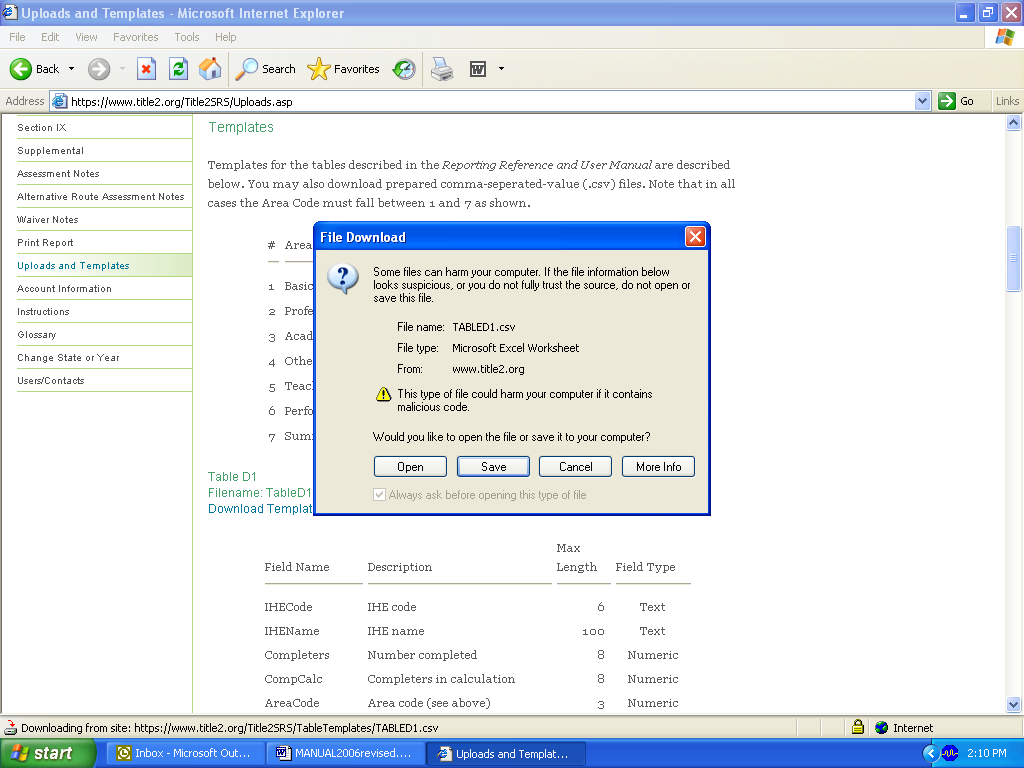
State
Reporting System to be updated upon approval of data collection
instrument
You can then open the file in Excel. You will see a blank spreadsheet with column headers. Figure III.F.26 is an example of what you would see opening the template for Table D1.
Figure III.F.26. Template for Table D1
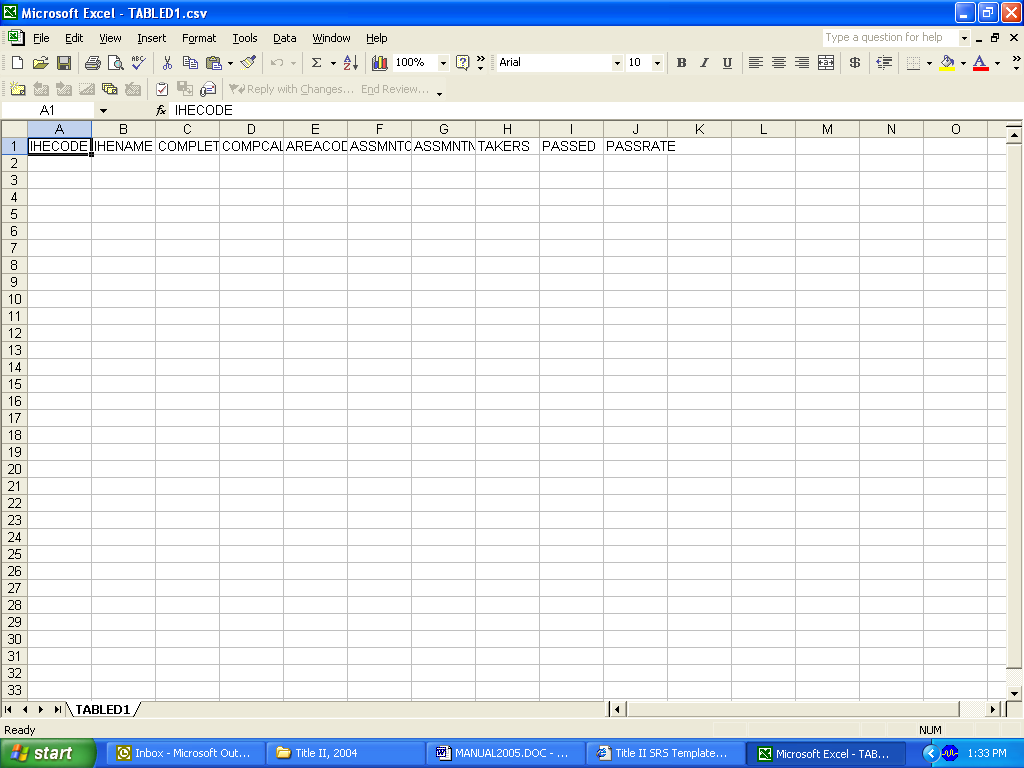
State
Reporting System to be updated upon approval of data collection
instrument
Once you have saved the spreadsheet on your hard drive or diskette, you can enter the data off-line. You do not need to remain in the SRS to work in the spreadsheet. (You may also enter the data on-line. See the appropriate section of this manual for instructions.) After you enter data into the template, save it on your hard drive or diskette! The file should automatically save as a .csv file again.
Be sure to remember where you save the template when you download it. After you enter the data, save the template again in the same location.
See Uploads for instructions on uploading templates into the SRS.
Instructions
From the left side of the page, click on the link for Instructions. This page provides basic instructions for using the SRS and also provides links to other resources (see Figure III.F.27). You will find links to the Reporting Reference and User Manual here.
Figure III.F.27. Instructions
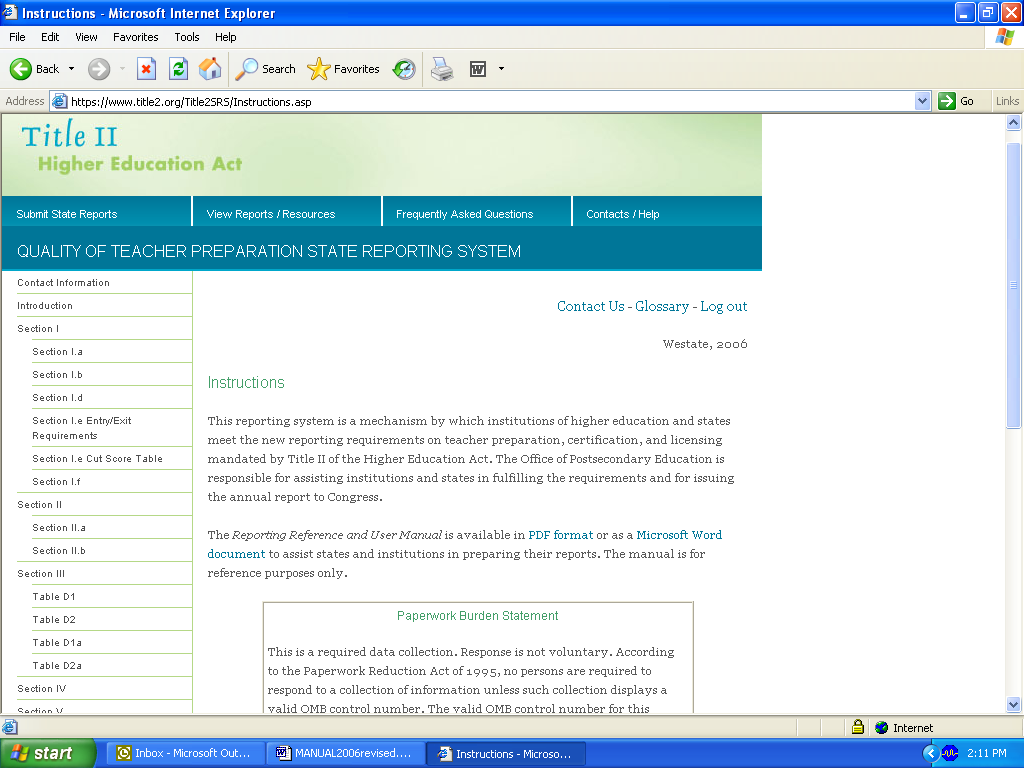
State
Reporting System to be updated upon approval of data collection
instrument
APPENDIX A
Statutory Provisions
Title
II, Sections 205 through 208 of the Higher Education Opportunity
Act
‘‘SEC. 205. ACCOUNTABILITY FOR PROGRAMS THAT PREPARE TEACHERS.
‘‘(a) INSTITUTIONAL AND PROGRAM REPORT CARDS ON THE QUALITY OF TEACHER PREPARATION.—
‘‘(1) REPORT CARD.—Each institution of higher education that conducts a traditional teacher preparation program or alternative routes to State certification or licensure program and that enrolls students receiving Federal assistance under this Act shall report annually to the State and the general public, in a uniform and comprehensible manner that conforms with the definitions and methods established by the Secretary, the following:
‘‘(A) GOALS AND ASSURANCES.—
‘‘(i) For the most recent year for which the information is available for the institution—
‘‘(I) whether the goals set under section 206 have been met; and
‘‘(II) a description of the activities the institution implemented to achieve such goals.
‘‘(ii) A description of the steps the institution is taking to improve its performance in meeting the annual goals set under section 206.
‘‘(iii) A description of the activities the institution has implemented to meet the assurances provided under section 206.
‘‘(B) PASS RATES AND SCALED SCORES.—For the most recent year for which the information is available for those students who took the assessments used for teacher certification or licensure by the State in which the program is located and are enrolled in the traditional teacher preparation program or alternative routes to State certification or licensure program, and for those who have taken such assessments and have completed the traditional teacher preparation program or alternative routes to State certification or licensure program during the two-year period preceding such year, for each of such assessments—
‘‘(i) the percentage of students who have completed 100 percent of the nonclinical coursework and taken the assessment who pass such assessment;
‘‘(ii) the percentage of all students who passed such assessment;
‘‘(iii) the percentage of students who have taken such assessment who enrolled in and completed the traditional teacher preparation program or alternative routes to State certification or licensure program, as applicable;
‘‘(iv) the average scaled score for all students who took such assessment;
‘‘(v) a comparison of the program’s pass rates with the average pass rates for programs in the State; and
‘‘(vi) a comparison of the program’s average scaled scores with the average scaled scores for programs
in the State.
‘‘(C) PROGRAM INFORMATION.—A description of—
‘‘(i) the criteria for admission into the program;
‘‘(ii) the number of students in the program (disaggregated by race, ethnicity, and gender);
‘‘(iii) the average number of hours of supervised clinical experience required for those in the program;
‘‘(iv) the number of full-time equivalent faculty and students in the supervised clinical experience; and
‘‘(v) the total number of students who have been certified or licensed as teachers, disaggregated by subject and area of certification or licensure.
‘‘(D) STATEMENT.—In States that require approval or accreditation of teacher preparation programs, a statement of whether the institution’s program is so approved or accredited, and by whom.
‘‘(E) DESIGNATION AS LOW-PERFORMING.—Whether the program has been designated as low-performing by the State under section 207(a).
‘‘(F) USE OF TECHNOLOGY.—A description of the activities, including activities consistent with the principles of universal design for learning, that prepare teachers to integrate technology effectively into curricula and instruction, and to use technology effectively to collect, manage, and analyze data in order to improve teaching and learning for the purpose of increasing student academic achievement.
‘‘(G) TEACHER TRAINING.—A description of the activities that prepare general education and special education teachers to teach students with disabilities effectively, including training related to participation as a member of individualized education program teams, as defined in section 614(d)(1)(B) of the Individuals with Disabilities Education Act, and to effectively teach students who are limited English proficient.
‘‘(2) REPORT.—Each eligible partnership receiving a grant under section 202 shall report annually on the progress of the eligible partnership toward meeting the purposes of this part and the objectives and measures described in section 204(a).
‘‘(3) FINES.—The Secretary may impose a fine not to exceed $27,500 on an institution of higher education for failure to provide the information described in this subsection in a timely or accurate manner.
‘‘(4) SPECIAL RULE.—In the case of an institution of higher education that conducts a traditional teacher preparation program or alternative routes to State certification or licensure program and has fewer than 10 scores reported on any single initial teacher certification or licensure assessment during an academic year, the institution shall collect and publish information, as required under paragraph (1)(B), with respect to an average pass rate and scaled score on each State certification or licensure assessment taken over a three-year period.
‘‘(b) STATE REPORT CARD ON THE QUALITY OF TEACHER PREPARATION.—
‘‘(1) IN GENERAL.—Each State that receives funds under this Act shall provide to the Secretary, and make widely available to the general public, in a uniform and comprehensible manner that conforms with the definitions and methods established by the Secretary, an annual State report card on the quality of teacher preparation in the State, both for traditional teacher preparation programs and for alternative routes to State certification or licensure programs, which shall include not less than the following:
‘‘(A) A description of the reliability and validity of the teacher certification and licensure assessments, and any other certification and licensure requirements, used by the State.
‘‘(B) The standards and criteria that prospective teachers must meet to attain initial teacher certification or licensure and to be certified or licensed to teach particular academic subjects, areas, or grades within the State.
‘‘(C) A description of how the assessments and requirements described in subparagraph (A) are aligned with the State’s challenging academic content standards required under section 1111(b)(1) of the Elementary and Secondary Education Act of 1965 and, as applicable, State early learning standards for early childhood education programs.
‘‘(D) For each of the assessments used by the State for teacher certification or licensure—
‘‘(i) for each institution of higher education located in the State and each entity located in the State, including those that offer an alternative route for teacher certification or licensure, the percentage of students at such institution or entity who have completed 100 percent of the nonclinical coursework and taken the assessment who pass such assessment;
‘‘(ii) the percentage of all such students at all such institutions and entities who have taken the assessment who pass such assessment;
‘‘(iii) the percentage of students who have taken the assessment who enrolled in and completed a teacher preparation program; and
‘‘(iv) the average scaled score of individuals participating in such a program, or who have completed such a program during the two-year period preceding the first year for which the annual State report card is provided, who took each such assessment.
‘‘(E) A description of alternative routes to teacher certification or licensure in the State (including any such routes operated by entities that are not institutions of higher education), if any, including, for each of the assessments used by the State for teacher certification or licensure—
‘‘(i) the percentage of individuals participating in such routes, or who have completed such routes during the two-year period preceding the date for which the determination is made, who passed each such assessment; and
‘‘(ii) the average scaled score of individuals participating in such routes, or who have completed such routes during the two-year period preceding the first year for which the annual State report card is provided, who took each such assessment.
‘‘(F) A description of the State’s criteria for assessing the performance of teacher preparation programs within institutions of higher education in the State. Such criteria shall include indicators of the academic content knowledge and teaching skills of students enrolled in such programs.
‘‘(G) For each teacher preparation program in the State—
‘‘(i) the criteria for admission into the program;
‘‘(ii) the number of students in the program, disaggregated by race, ethnicity, and gender (except that such disaggregation shall not be required in a case in which the number of students in a category is insufficient to yield statistically reliable information or the results would reveal personally identifiable information about an individual student);
‘‘(iii) the average number of hours of supervised clinical experience required for those in the program; and
‘‘(iv) the number of full-time equivalent faculty, adjunct faculty, and students in supervised clinical experience.
‘‘(H) For the State as a whole, and for each teacher preparation program in the State, the number of teachers prepared, in the aggregate and reported separately by—
‘‘(i) area of certification or licensure;
‘‘(ii) academic major; and
‘‘(iii) subject area for which the teacher has been prepared to teach.
‘‘(I) A description of the extent to which teacher preparation programs are addressing shortages of highly qualified teachers, by area of certification or licensure, subject, and specialty, in the State’s public schools.
‘‘(J) The extent to which teacher preparation programs prepare teachers, including general education and special education teachers, to teach students with disabilities effectively, including training related to participation as a member of individualized education program teams, as defined in section 614(d)(1)(B) of the Individuals with Disabilities Education Act.
‘‘(K) A description of the activities that prepare teachers to—
‘‘(i) integrate technology effectively into curricula and instruction, including activities consistent with the principles of universal design for learning; and
‘‘(ii) use technology effectively to collect, manage, and analyze data to improve teaching and learning for the purpose of increasing student academic achievement.
‘‘(L) The extent to which teacher preparation programs prepare teachers, including general education and special education teachers, to effectively teach students who are limited English proficient.
‘‘(2) PROHIBITION AGAINST CREATING A NATIONAL LIST.—
The Secretary shall not create a national list or ranking of States, institutions, or schools using the scaled scores provided under this subsection.
‘‘(c) DATA QUALITY.—The Secretary shall prescribe regulations to ensure the reliability, validity, integrity, and accuracy of the data submitted pursuant to this section.
‘‘(d) REPORT OF THE SECRETARY ON THE QUALITY OF TEACHER PREPARATION.—
‘‘(1) REPORT CARD.—The Secretary shall annually provide to the authorizing committees, and publish and make widely available, a report card on teacher qualifications and preparation in the United States, including all the information reported in subparagraphs (A) through (L) of subsection (b)(1). Such
report shall identify States for which eligible partnerships received a grant under this part.
‘‘(2) REPORT TO CONGRESS.—The Secretary shall prepare and submit a report to the authorizing committees that contains the following:
‘‘(A) A comparison of States’ efforts to improve the quality of the current and future teaching force.
‘‘(B) A comparison of eligible partnerships’ efforts to improve the quality of the current and future teaching force.
‘‘(C) The national mean and median scaled scores and pass rate on any standardized test that is used in more than one State for teacher certification or licensure.
‘‘(3) SPECIAL RULE.—In the case of a teacher preparation program with fewer than ten scores reported on any single initial teacher certification or licensure assessment during an academic year, the Secretary shall collect and publish, and make publicly available, information with respect to an average pass rate and scaled score on each State certification or licensure assessment taken over a three-year period.
‘‘(e) COORDINATION.—The Secretary, to the extent practicable, shall coordinate the information collected and published under this part among States for individuals who took State teacher certification or licensure assessments in a State other than the State in which the individual received the individual’s most recent degree.
SEC. 206. TEACHER DEVELOPMENT.
‘‘(a) ANNUAL GOALS.—Each institution of higher education that conducts a traditional teacher preparation program (including programs that offer any ongoing professional development programs) or alternative routes to State certification or licensure program, and that enrolls students receiving Federal assistance under this Act, shall set annual quantifiable goals for increasing the number of prospective teachers trained in teacher shortage areas designated by the Secretary or by the State educational agency, including mathematics, science, special education, and instruction of limited English proficient students.
‘‘(b) ASSURANCES.—Each institution described in subsection (a) shall provide assurances to the Secretary that—
‘‘(1) training provided to prospective teachers responds to the identified needs of the local educational agencies or States where the institution’s graduates are likely to teach, based on past hiring and recruitment trends;
‘‘(2) training provided to prospective teachers is closely linked with the needs of schools and the instructional decisions new teachers face in the classroom;
‘‘(3) prospective special education teachers receive coursework in core academic subjects and receive training in providing instruction in core academic subjects;
‘‘(4) general education teachers receive training in providing instruction to diverse populations, including children with disabilities, limited English proficient students, and children from low-income families; and
‘‘(5) prospective teachers receive training on how to effectively teach in urban and rural schools, as applicable.
‘‘(c) RULE OF CONSTRUCTION.—Nothing in this section shall be construed to require an institution to create a new teacher preparation area of concentration or degree program or adopt a specific curriculum in complying with this section.
‘‘SEC. 207. STATE FUNCTIONS.
‘‘(a) STATE ASSESSMENT.—In order to receive funds under this Act, a State shall conduct an assessment to identify low-performing H. R. 4137—76 teacher preparation programs in the State and to assist such programs through the provision of technical assistance. Each such State shall provide the Secretary with an annual list of low-performing teacher preparation programs and an identification of those programs at risk of being placed on such list, as applicable. Such assessment shall be described in the report under section 205(b).
Levels of performance shall be determined solely by the State and may include criteria based on information collected pursuant to this part, including progress in meeting the goals of—
‘‘(1) increasing the percentage of highly qualified teachers in the State, including increasing professional development opportunities;
‘‘(2) improving student academic achievement for elementary and secondary students; and
‘‘(3) raising the standards for entry into the teaching profession.
‘‘(b) TERMINATION OF ELIGIBILITY.—Any teacher preparation program from which the State has withdrawn the State’s approval, or terminated the State’s financial support, due to the low performance of the program based upon the State assessment described in subsection (a)—
‘‘(1) shall be ineligible for any funding for professional development activities awarded by the Department;
‘‘(2) may not be permitted to accept or enroll any student who receives aid under title IV in the institution’s teacher preparation program;
‘‘(3) shall provide transitional support, including remedial services if necessary, for students enrolled at the institution at the time of termination of financial support or withdrawal of approval; and
‘‘(4) shall be reinstated upon demonstration of improved performance, as determined by the State.
‘‘(c) NEGOTIATED RULEMAKING.—If the Secretary develops any regulations implementing subsection (b)(2), the Secretary shall submit such proposed regulations to a negotiated rulemaking process, which shall include representatives of States, institutions of higher education, and educational and student organizations.
‘‘(d) APPLICATION OF THE REQUIREMENTS.—The requirements of this section shall apply to both traditional teacher preparation programs and alternative routes to State certification and licensure programs.
‘‘SEC. 208. GENERAL PROVISIONS.
‘‘(a) METHODS.—In complying with sections 205 and 206, the Secretary shall ensure that States and institutions of higher education use fair and equitable methods in reporting and that the reporting methods do not reveal personally identifiable information.
‘‘(b) SPECIAL RULE.—For each State that does not use content assessments as a means of ensuring that all teachers teaching in core academic subjects within the State are highly qualified, as required under section 1119 of the Elementary and Secondary Education Act of 1965, in accordance with the State plan submitted or revised under section 1111 of such Act, and that each person employed as a special education teacher in the State who teaches elementary school or secondary school is highly qualified by the deadline, as required under section 612(a)(14)(C) of the Individuals with Disabilities Education Act, the Secretary shall—
‘‘(1) to the extent practicable, collect data comparable to the data required under this part from States, local educational agencies, institutions of higher education, or other entities that administer such assessments to teachers or prospective teachers; and
‘‘(2) notwithstanding any other provision of this part, use such data to carry out requirements of this part related to assessments, pass rates, and scaled scores.
‘‘(c) RELEASE OF INFORMATION TO TEACHER PREPARATION PROGRAMS.—
‘‘(1) IN GENERAL.—For the purpose of improving teacher preparation programs, a State that receives funds under this Act, or that participates as a member of a partnership, consortium, or other entity that receives such funds, shall provide to a teacher preparation program, upon the request of the teacher preparation program, any and all pertinent education related information that—
‘‘(A) may enable the teacher preparation program to evaluate the effectiveness of the program’s graduates or the program itself; and
‘‘(B) is possessed, controlled, or accessible by the State.
‘‘(2) CONTENT OF INFORMATION.—The information described in paragraph (1)—
‘‘(A) shall include an identification of specific individuals who graduated from the teacher preparation program to enable the teacher preparation program to evaluate the information provided to the program from the State with the program’s own data about the specific courses taken by, and field experiences of, the individual graduates; and
‘‘(B) may include—
‘‘(i) kindergarten through grade 12 academic achievement and demographic data, without revealing personally identifiable information about an individual student, for students who have been taught by graduates of the teacher preparation program; and
‘‘(ii) teacher effectiveness evaluations for teachers who graduated from the teacher preparation program
APPENDIX
B
Glossary
Academic year: A period of 12 consecutive months, starting September 1 and ending August 31.
Alternative route to certification or licensure: A teacher preparation program that primarily serves candidates that are the teacher of record in a classroom while participating in the route. Alternative route teacher preparation programs are defined as such by the state.
Challenging academic content standards: Standards that specify what children are expected to know and be able to do; contain coherent and rigorous content; and encourage the teaching of advanced skills.
Cohort of program completers: Individuals who met all requirements of a state-approved teacher preparation program in a given academic year. (See definition of “program completer.”)
Critical shortage area: See Teacher shortage area.
Cut score: The minimum score required by the state to pass a teacher certification or licensure assessment.
Early childhood education program: A Head Start program or an Early Head Start program carried out under the Head Start Act (42 U.S.C. 9831 et seq.), including a migrant or seasonal Head Start program, an Indian Head Start program, or a Head Start program or an Early Head Start program that also receives State funding; a State licensed or regulated child care program; or a program that serves children from birth through age six that addresses the children's cognitive (including language, early literacy, and early mathematics), social, emotional, and physical development; and is a State prekindergarten program; a program authorized under section 619 or part C of the Individuals with Disabilities Education Act; or a program operated by a local educational agency.
Elementary school: [A] day or residential school which provides elementary education, as determined under State law. (See section 14101(14) of the Elementary and Secondary Education Act.)
Enrolled student: A student who has been admitted to a teacher preparation program, but who has not yet completed the program.
Highly qualified teacher: A teacher that has a bachelor’s degree, full state certification and has demonstrated competency in all subjects in which he or she teaches. A highly qualified teacher has not had any certification or licensure requirements waived on an emergency, temporary or provisional basis.
Highly qualified teachers in alternative routes: Any teacher who has obtained full state certification (whether he or she has achieved certification through traditional or alternate routes), has a 4-year college degree and has demonstrated subject matter competence in each of the core academic subjects in which he or she is or will be teaching is considered to be “highly qualified” under the law. Teachers who are participating in alternate route programs may be considered to meet the certification requirements of the definition of a highly qualified teacher (and not be counted as on a waiver) if they are permitted by the state to assume functions as regular classroom teachers only for a specified period of time not to exceed three years and demonstrate satisfactory progress toward full certification in their program as prescribed by the state. Their alternate route program must provide high-quality professional development that is sustained, intensive and classroom-focused in order to have a positive and lasting impact on classroom instruction, before and while teaching. Teachers in such a program must also participate in a program of intensive supervision that consists of structured guidance and regular ongoing support for teachers or a teacher mentoring program.
Individualized education program (IEP) team: The term `individualized education program team' or `IEP Team' means a group of individuals composed of the parents of a child with a disability; not less than 1 regular education teacher of such child (if the child is, or may be, participating in the regular education environment); not less than 1 special education teacher, or where appropriate, not less than 1 special education provider of such child; a representative of the local educational agency who is qualified to provide, or supervise the provision of, specially designed instruction to meet the unique needs of children with disabilities; is knowledgeable about the general education curriculum; and is knowledgeable about the availability of resources of the local educational agency; an individual who can interpret the instructional implications of evaluation results, who may be a member of the team described above; at the discretion of the parent or the agency, other individuals who have knowledge or special expertise regarding the child, including related services personnel as appropriate; and whenever appropriate, the child with a disability.
Initial certification: The first teaching certificate or license issued to an individual. The specific certificates or licenses classified as initial certification in each state are defined by the state. States are to provide information on degree, coursework, assessment, supervised clinical experiences and other requirements.
Institution of Higher Education: Section 101(a) of the Higher Education Opportunity Act provides a general definition of “institution of higher education,” as follows:
“For purposes of this Act, other than Title IV [Student Financial Assistance], the term ‘institution of higher education’ means an educational institution in any State that —
admits as regular students only persons having a certificate of graduation from a school providing secondary education, or the recognized equivalent of such a certificate, or persons who meet the requirements of section 484(d)(3);
is legally authorized within such State to provide a program of education beyond secondary education;
provides an educational program for which the institution awards a bachelor’s degree or provides not less than a 2-year program that is acceptable for full credit toward such a degree, or awards a degree that is acceptable for admission to a graduate or professional degree program, subject to review and approval by the Secretary;
is a public or other nonprofit institution; and
is accredited by a nationally recognized accrediting agency or association, or if not so accredited, is an institution that has been granted preaccreditation status by such an agency or association that has been recognized by the Secretary for the granting of preaccreditation status, and the Secretary has determined that there is a satisfactory assurance that the institution will meet the accreditation standards of such an agency or association within a reasonable time.”
Section 101(b) defines additional institutions that are included:
“For purposes of this Act, other than Title IV, the term ‘institution of higher education’ also includes —
any school that provides not less than a 1-year program of training to prepare students for gainful employment in a recognized occupation and that meets the provision of paragraphs (1), (2), (4), and (5) of subsection (a); and
a public or nonprofit private educational institution in any State that, in lieu of the requirements in subsection (a)(1), admits as regular students individuals—
who are beyond the age of compulsory school attendance in the State in which the institution is located; or
who will be dually or concurrently enrolled in the institution and a secondary school."
Limited English proficient student: A student who is aged 3 through 21; who is enrolled or preparing to enroll in an elementary school or secondary school; who was not born in the United States or whose native language is a language other than English; who is a Native American or Alaska Native, or a native resident of the outlying areas; and who comes from an environment where a language other than English has had a significant impact on the individual's level of English language proficiency; or who is migratory, whose native language is a language other than English, and who comes from an environment where a language other than English is dominant; and whose difficulties in speaking, reading, writing, or understanding the English language may be sufficient to deny the individual the ability to meet the State's proficient level of achievement on state assessments described in section 1111(b)(3) of the No Child Left Behind Act of 2001; the ability to successfully achieve in classrooms where the language of instruction is English; or the opportunity to participate fully in society.
Nonclinical coursework: Any course in the teacher preparation program curriculum that focuses on content, such as academic subject matter, and does not require students to participate in the activities of supervised clinical experience as described in the glossary definition may be counted as nonclinical coursework. The curriculum policies of each state and its institutions will identify coursework that is nonclinical or clinical. See Supervised clinical experience
Pass rate: The percentage of students who passed assessment(s) taken for initial certification or licensure in the field of preparation.
Single assessment pass rate: The percentage of students who passed the assessment among all who took the assessment.
Summary pass rate: The percentage of students who passed all tests they took for their area of specialization among those who took one or more tests in their specialization areas.
Program completer: A person who has met all the requirements of a state-approved teacher preparation program. Program completers include all those who are documented as having met such requirements. Documentation may take the form of a degree, institutional certificate, program credential, transcript or other written proof of having met the program’s requirements. In applying this definition, the fact that an individual has or has not been recommended to the state for initial certification or licensure may not be used as a criterion for determining who is a program completer.
Reliability: Reliability is the consistency of your measurement, or the degree to which an instrument measures the same way each time it is used under the same condition with the same subjects. In short, it is the repeatability of your measurement. A measure is considered reliable if a person's score on the same test given twice is similar. It is important to remember that reliability is not measured, it is estimated. There are two ways that reliability is usually estimated: test/retest and internal consistency.
Reporting to the general public: Making the information in institutional and state reports available widely and publicly to members of the public interested in the performance of the institution’s teacher preparation program. For institutions, this can include providing the required information in publications such as school catalogues and promotional materials sent to potential applicants, secondary guidance counselors, and prospective employers of the institution’s graduates.
Reporting to the Secretary: Submitting annual state reports to the Office of Postsecondary Education in the U.S. Department of Education.
Reporting to the state: Submitting annual institutional reports to the state agency, commission, or board, in the state in which the institution is located, that is responsible for preparing the state report under section 205.
Scaled score: A scaled score is a conversion of a student's raw score on a test or a version of the test to a common scale that allows for a numerical comparison between students. Because most major testing programs use multiple versions of a test, the scale is used to control slight variations from one version of a test to the next. Scaled scores are particularly useful for comparing test scores over time, such as measuring semester-to-semester and year-to-year growth of individual students or groups of students in a content area. However, within the same test, different content areas are typically on different scales, so a scaled score of 24 in Mathematics may not mean the same as a scaled score of 24 in Reading.
Secondary school: “[A] day or residential school which provides secondary education, as determined under State law, except that it does not include any education provided beyond grade 12.” (See section 14101(25) of the Elementary and Secondary Education Act.)
Single assessment pass rate: See definition of “pass rate.”
State: Any of the states of the United States, as well as the Commonwealth of Puerto Rico, the District of Columbia, Guam, American Samoa, the United States Virgin Islands, the Commonwealth of the Northern Mariana Islands, and the Freely Associated States (the Republic of the Marshall Islands, the Federated States of Micronesia and the Republic of Palau).
Student: An individual enrolled in a teacher preparation program leading to an initial state teaching certificate or license.
Summary pass rate: See definition of “pass rate.”
Supervised clinical experience: A series of supervised field experiences (including student teaching) with PK-12 students that occur as a sequenced, integral part of the preparation program prior to the candidate becoming the teacher of record. Please note that Title II, Section 202 (d)(2) describes features of clinical experience as follows. Courses in the curriculum that include the activities described in 202(d)(2) may be considered clinical coursework. The curriculum policies of each state and its institutions will identify coursework that is clinical and nonclinical.
‘‘(2) CLINICAL EXPERIENCE AND INTERACTION.—Developing and improving a sustained and high-quality preservice clinical education program to further develop the teaching skills of all prospective teachers and, as applicable, early childhood educators, involved in the program. Such program shall do the following:
‘‘(A) Incorporate year-long opportunities for enrichment, including—
‘‘(i) clinical learning in classrooms in high-need schools served by the high-need local educational
agency in the eligible partnership, and identified by the eligible partnership; and
‘‘(ii) closely supervised interaction between prospective teachers and faculty, experienced teachers, principals, other administrators, and school leaders at early childhood education programs (as applicable), elementary schools, or secondary schools, and providing support for such interaction.
‘‘(B) Integrate pedagogy and classroom practice and promote effective teaching skills in academic content areas.
‘‘(C) Provide high-quality teacher mentoring.
‘‘(D) Be offered over the course of a program of teacher preparation.
‘‘(E) Be tightly aligned with course work (and may be developed as a fifth year of a teacher preparation program).
‘‘(F) Where feasible, allow prospective teachers to learn to teach in the same local educational agency in which the teachers will work, learning the instructional initiatives and curriculum of that local educational agency.
‘‘(G) As applicable, provide training and experience to enhance the teaching skills of prospective teachers to better prepare such teachers to meet the unique needs of teaching in rural or urban communities.
‘‘(H) Provide support and training for individuals participating in an activity for prospective or new teachers described in this paragraph or paragraph (1) or (3), and for individuals who serve as mentors for such teachers, based on each individual’s experience. Such support may include—
‘‘(i) with respect to a prospective teacher or a mentor, release time for such individual’s participation;
‘‘(ii) with respect to a faculty member, receiving course workload credit and compensation for time teaching in the eligible partnership’s activities; and
‘‘(iii) with respect to a mentor, a stipend, which may include bonus, differential, incentive, or performance pay, based on the mentor’s extra skills and responsibilities.
Supervising Faculty: All persons whom the institution regards as having faculty status, who were assigned by the teacher preparation program to provide supervision and evaluation of student teaching and who have an administrative link or relationship to the teacher preparation program.
Teacher: For the purpose of reporting, a teacher is a classroom teacher, including special education and early childhood education teachers. A teacher is not a principal, vice principal, school administrator, guidance counselor, school social worker, speech/language pathologist or other school support personnel.
Teacher certification/licensure assessment: A test or other structured method that measures the qualifications of prospective teachers, has a pass-fail outcome and is used by the state for teacher certification or licensure.
Teacher preparation program: A state-approved course of study, the completion of which signifies that an enrollee has met all the state’s educational and/or training requirements for initial certification or licensure to teach in the state’s elementary, middle or secondary schools. A teacher preparation program may be either a traditional program or an alternative route to certification, as defined by the state. Also, it may be within or outside an institution of higher education.
In addition, for the purpose of reporting, the Reporting Reference and User Manual considers all traditional teacher preparation programs at a single institution of higher education to be a single program.
Teacher shortage area: As designated by the Secretary or by the State educational agency, including mathematics, science, special education, and instruction of limited English proficiency students (see Section 206(a)).
Teaching candidate: A completer of a teacher preparation program who has taken one or more assessments used by the state in which the program is located for initial teacher certification or licensure.
Teaching skills: Skills that enable a teacher to increase student learning, achievement, and the ability to apply knowledge; effectively convey and explain academic subject
matter; effectively teach higher-order analytical, evaluation, problem-solving, and communication skills; employ strategies grounded in the disciplines of teaching and learning that are based on empirically-based practice and scientifically valid research, where applicable, related to teaching and learning; are specific to academic subject matter; and focus on the identification of students’ specific learning needs, particularly students with disabilities, students who are limited English proficient, students who are gifted and talented, and students with low literacy levels, and the tailoring of academic instruction to such needs.
Test closure date: The date, specified by the state, after which test results will not be included in pass rates for an academic year cohort.
Traditional teacher preparation program: A teacher preparation program that primarily serves undergraduate students without prior teaching or work experience and leads at least to a bachelor’s degree.6
Universal design for learning: A scientifically valid framework for guiding educational practice that provides flexibility in the ways information is presented, in the ways students respond or demonstrate knowledge and skills, and in the ways students are engaged; and reduces barriers in instruction, provides appropriate accommodations, supports, and challenges, and maintains high achievement expectations for all students, including students with disabilities and students who are limited English proficient.
Validity: Validity is the strength of our conclusions, inferences or propositions. Experts define it as the “best available approximation to the truth or falsity of a given inference, proposition or conclusion.” In short, were we right? Let's look at a simple example. Say we are studying the effect of strict attendance policies on class participation. In our case, we saw that class participation did increase after the policy was established. Each type of validity would highlight a different aspect of the relationship between our treatment (strict attendance policy) and our observed outcome (increased class participation).
APPENDIX
C
Higher Education Opportunity Act
Institutional and Program Report Card on the Quality of Teacher Preparation
Office of Postsecondary Education
U.S. Department of Education
Institution Information
|
|
|
|
|
|
|
|
|
|
N
I
|
|
||||||||
C
|
|
||||||||
TQE partnership name or grant number, if applicable: ______________________________
State: ______________________________
Address: __________________________________________________________________ |
|
|
|
|
|||||
Contact person: _____________________________________________________________ |
|
|
|
|
|||||
Email: ___________________________________________________________________ |
|
|
|
|
|||||
Telephone no.: ( ) __________ - __________ |
|
|
|
|
|||||
Academic year: _____2009-10________________
Section 205 of Title II of the Higher Education Opportunity Act mandates that the Department of Education collect data on state assessments, other requirements, and standards for teacher certification and licensure, as well as data on the performance of teacher preparation programs. The law requires the Secretary to use these data in submitting an annual report on the quality of teacher preparation to the Congress. The first Secretarial report is due XXX. Annual state reports to the Secretary are first due on XXX. Data from institutions with teacher preparation programs are due to states annually, beginning XXX, for use by states in preparing annual report cards to the Secretary.
Paperwork Burden Statement This is a required data collection. Response is not voluntary. According to the Paperwork Reduction Act of 1995, no persons are required to respond to a collection of information unless such collection displays a valid OMB control number. The valid OMB control number for this information collection is 1840-XXXX (expiration date: X/X/20XX). The time required for institutions to complete this information collection is estimated to average XX hours per response, including the time to review instructions, search existing data resources, gather the data needed, and complete and review the information collection. If you have any comments concerning the accuracy of the time estimate(s) or suggestions for improving this form, please write to: U.S. Department of Education, Washington, DC 20202-4651. If you have comments or concerns regarding the status of your individual submission of this form, write directly to: Assistant Secretary, Office of Postsecondary Education, U.S. Department of Education, 1990 K Street, NW, Room 7115, Washington, DC 20006.
|
Note: The procedures for developing the information required for these tables are explained in the Higher Education Opportunity Act, Title II: Reporting Reference and User Manual. Terms and phrases in this questionnaire are defined in the glossary, appendix X of the manual.
Section I. Program information
For each element listed below, check if it is required for admission into any of your initial teacher certification program(s) at either the undergraduate (UG) or postgraduate (PG) level. (§205(a)(1)(C)(i))
-
Element
UG
PG
Application
Fee/payment
Transcript
Fingerprint check
Background check
Experience in a classroom or working with children
Minimum number of courses/credits/semester hours completed
Minimum high school GPA
Minimum undergraduate GPA
Minimum GPA in content area coursework
Minimum GPA in professional education coursework
ACT
SAT
GRE
Basic skills test
Subject area/academic content test or other subject matter verification
Miller Analogies test
Recommendation(s)
Essay or personal statement
Interview
Résumé
Bachelor’s degree or higher
Job offer from school/district
Personality test (e.g., Myers-Briggs Assessment)
Other (specify:_______________________________________)
Provide a link to your website where additional information about admissions requirements can be found:
__________________________________________________
Indicate when students are formally admitted into your initial teacher certification program (freshman year, sophomore year, junior year, senior year, postgraduate): __________________________________
Does your initial teacher certification program conditionally admit students? Yes No
Provide the number of students in the teacher preparation program in the following categories. Note that you must report on the number of students by ethnicity and race separately. Also note that individuals can belong to one or more racial groups, so the sum of the members of each racial category may not necessarily add up to the total number of students enrolled. (§205(a)(1)(C)(ii))
-
Total number of students enrolled in 2009-10
-
Unduplicated number of males enrolled in 2009-10
Unduplicated number of females enrolled in 2009-10
-
2009-10
Number enrolled
Ethnicity
Hispanic/Latino(a)
Not Hispanic/Latino(a)
Race
American Indian or Alaska Native
Asian
Black or African American
Native Hawaiian or Pacific Islander
White
Provide the following information about supervised clinical experience in 2009-10. (§205(a)(1)(C)(iii), §205(a)(1)(C)(iv))
-
Average number of clock hours required for pre-student teaching
Average number of clock hours required for student teaching
Number of full-time equivalent faculty in supervised clinical experience during this academic year
Number of full-time equivalent adjunct faculty in supervised clinical experience during this academic year (IHE and PreK-12 staff)
Number of students in supervised clinical experience during this academic year
Provide the number of students who have been certified or licensed as teachers, by subject and area of certification or licensure. (§205(a)(1)(C)(v))
-
Teaching subject/area
Number certified/licensed
2009-10
Number certified/licensed
2008-09
Number certified/licensed
2007-08
TOTAL (all areas/subjects)
Provide the total number of initial teacher certification preparation program completers in each of the following academic years:
-
2009-10
2008-09
2007-08
Section II. Goals and assurances
ANNUAL GOALS
Each institution of higher education (IHE) that conducts a traditional teacher preparation program (including programs that offer any ongoing professional development programs) or alternative routes to state certification or licensure program, and that enrolls students receiving Federal assistance under this Act, shall set annual quantifiable goals for increasing the number of prospective teachers trained in teacher shortage areas designated by the Secretary or by the state educational agency, including mathematics, science, special education, and instruction of limited English proficient students. IHEs that do not have a teacher preparation program in one or more of the areas listed below can enter NA for the area(s) in which the IHE does not have that program. (§205(a)(1)(A)(i), §205(a)(1)(A)(ii), §206(a))
Teacher shortage area in 2009-10 |
Goal |
Goal met? (Y/N) |
Description of strategies used to achieve goal |
Description of steps to improve performance in meeting goal or lessons learned in meeting goal |
Mathematics |
|
|
|
|
Science |
|
|
|
|
Special education |
|
|
|
|
Instruction of limited English proficient students |
|
|
|
|
Other (specify: ____________) |
|
|
|
|
Provide any additional comments, exceptions and explanations below:
ASSURANCES
Place a check next to each statement certifying that your institution is in compliance with the following assurances. (§205(a)(1)(A)(iii), §206(b))
training provided to prospective teachers responds to the identified needs of the local educational agencies or States where the institution’s graduates are likely to teach, based on past hiring and recruitment trends;
t
![]()
p
![]()
general education teachers receive training in providing instruction to children with disabilities;
![]()
general education teachers receive training in providing instruction to limited English proficient students;
![]()
general education teachers receive training in providing instruction to children from low-income families; and
prospective teachers receive training on how to effectively teach in urban and rural schools, as applicable.
Describe your institution’s most successful strategies in meeting the assurances listed above:
Section III. Pass rates and scaled scores
Provide the information in the following tables on the performance of the students in your teacher preparation program on each teacher certification/licensure assessment used by your state. This information will be provided to your institution by the state or the testing company or companies (or entities). In cases where a student has taken a given assessment more than once, the highest score on that test must be used. There must be at least 10 students in each category taking the same assessment in an academic year for data on that assessment to be reported; for summary data, there must also be at least 10 students (although not necessarily taking the same assessment) for data to be reported. In cases where there are less than 10 students taking the same assessment and the assessment pass rate is not reported, those students must be included in the summary data. Enrolled students are those students admitted to the teacher preparation program who have not yet completed the program.
In the case of a teacher preparation program with fewer than 10 scores reported on any single initial teacher certification or licensure assessment during an academic year, the program shall collect and publish information with respect to an average pass rate and scaled score on each state certification or licensure assessment taken over a three-year period.
ASSESSMENT PASS RATES (§205(a)(1)(B))
Assessment name Assessment code Test company/entity code Assessment cut score |
Number taking test |
Average |
Number passing test |
Pass
rate |
Statewide average pass rate (%) |
Statewide average scaled score |
All enrolled students who have completed all nonclinical courses, 2009-10 |
|
|
|
|
|
|
Other enrolled students, 2009-10 |
|
|
|
|
|
|
All program completers, 2009-2010 |
|
|
|
|
|
|
All program completers, 2008-2009 |
|
|
|
|
|
|
All program completers, 2007-2008 |
|
|
|
|
|
|
SUMMARY PASS RATES
|
Number taking one or more required tests |
Number passing all tests taken |
Pass
rate |
Statewide average pass rate (%) |
All enrolled students who have completed all nonclinical courses, 2009-10 |
|
|
|
|
Other enrolled students, 2009-10 |
|
|
|
|
All program completers, 2009-2010 |
|
|
|
|
All program completers, 2008-2009 |
|
|
|
|
All program completers, 2007-2008 |
|
|
|
|
Section IV. Statement and Designation as Low-Performing
Provide the following information about the approval or accreditation of your teacher preparation program. (§205(a)(1)(D), §205(a)(1)(E))
(A) Is your teacher preparation program currently approved or accredited?
_____ Yes _____ No
If yes, please specify the organization(s) that approved or accredited your program:
_____ State _____ NCATE _____ TEAC _____ Other (specify:_________________________)
(B) Is your teacher preparation program currently under a designation as “low-performing” by the state (as per section 207(a) of the HEA of 2008)? _____ Yes _____ No
NOTE: See appendix X of the manual for the legislative language referring to “low-performing” programs.
Section V. Use of Technology (§205(a)(1)(F))
Does your program prepare teachers to:
(A) integrate technology effectively into curricula and instruction _____ Yes _____ No
(B) use technology effectively to collect data to improve teaching and learning _____ Yes _____ No
(C) use technology effectively to manage data to improve teaching and learning _____ Yes _____ No
(D) use technology effectively to analyze data to improve teaching and learning _____ Yes _____ No
Provide a description of how your program prepares teachers to integrate technology effectively into curricula and instruction, and to use technology effectively to collect, manage, and analyze data in order to improve teaching and learning for the purpose of increasing student academic achievement. Include a description of how your program prepares teachers to use the principles of universal design for learning, as applicable. Include planning activities and a timeline if any of the four elements listed above are not currently in place.
Section VI. Teacher Training (§205(a)(1)(G))
Does your program prepare general education teachers to:
(A) teach students with disabilities effectively _____ Yes _____ No
(B) participate as a member of individualized education program teams _____ Yes _____ No
(C) teach students who are limited English proficient effectively _____ Yes _____ No
Does your program prepare special education teachers to:
(D) teach students with disabilities effectively _____ Yes _____ No
(E) participate as a member of individualized education program teams _____ Yes _____ No
(F) teach students who are limited English proficient effectively _____ Yes _____ No
Provide a description of how your program prepares general education and special education teachers to teach students with disabilities effectively, including training related to participation as a member of individualized education program teams, as defined in section 614(d)(1)(B) of the Individuals with Disabilities Education Act7, and to effectively teach students who are limited English proficient. Include planning activities and a timeline if any of the six elements listed above are not currently in place.
Section VII. Contextual information (optional)
Please use this space to provide any additional information that describes your teacher preparation program(s). You may also attach information to this report card. The U.S. Department of Education is especially interested in any evaluation plans or interim or final reports that may be available.
Section VIII. Certification
I certify that, to the best of my knowledge, the information in this report is accurate and complete and conforms to the definitions and instructions used in the Higher Education Opportunity Act, Title II: Reporting Reference and User Manual.
_____________________________ Signature
_____________________________ Name of responsible representative for teacher preparation program
______________________________ Title
Certification of review of submission:
______________________________ Signature
______________________________ Name of President/Chief Executive (or designee)
______________________________ Title
APPENDIX
D
State Survey
For
Use in Preparing the State Report
The State Survey must be submitted on-line through the State Reporting System (SRS). The SRS may be accessed at https://title2.ed.gov/default.asp.
1 Some traditional teacher preparation programs may lead to a teaching credential but not a degree. A traditional teacher preparation program in the outlying areas may lead to an associate’s degree.
2 Also includes program completer data for two previous years.
3 The “reporting year” is the period during which the reports from the IHEs to the states, and the states to Congress, are being assembled and submitted. For example, in the 2011-12 reporting year example in the table, the IHEs report to the states by April 2011, and the states report to the Department by October 2011. The Department’s report should then be sent to Congress by April 2012.
4 Some traditional teacher preparation programs may lead to a teaching credential but not a degree. A traditional teacher preparation program in the outlying areas may lead to an associate’s degree.
5 Some traditional teacher preparation programs may lead to a teaching credential but not a degree. A traditional teacher preparation program in the outlying areas may lead to an associate’s degree.
6 Some traditional teacher preparation programs may lead to a teaching credential but not a degree. A traditional teacher preparation program in the outlying areas may lead to an associate’s degree.
7 The term `individualized education program team' or `IEP Team' means a group of individuals composed of the parents of a child with a disability; not less than 1 regular education teacher of such child (if the child is, or may be, participating in the regular education environment); not less than 1 special education teacher, or where appropriate, not less than 1 special education provider of such child; a representative of the local educational agency who is qualified to provide, or supervise the provision of, specially designed instruction to meet the unique needs of children with disabilities; is knowledgeable about the general education curriculum; and is knowledgeable about the availability of resources of the local educational agency; an individual who can interpret the instructional implications of evaluation results, who may be a member of the team described above; at the discretion of the parent or the agency, other individuals who have knowledge or special expertise regarding the child, including related services personnel as appropriate; and whenever appropriate, the child with a disability.
| File Type | application/msword |
| Author | WESTAT |
| Last Modified By | Kate Mullan |
| File Modified | 2014-09-16 |
| File Created | 2014-09-16 |
© 2025 OMB.report | Privacy Policy